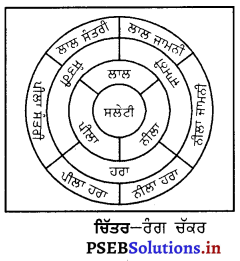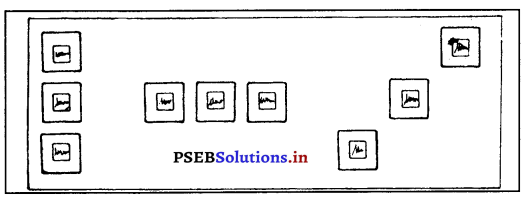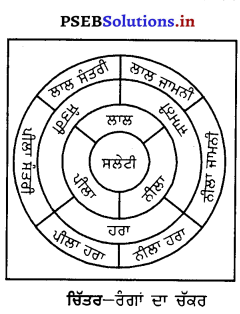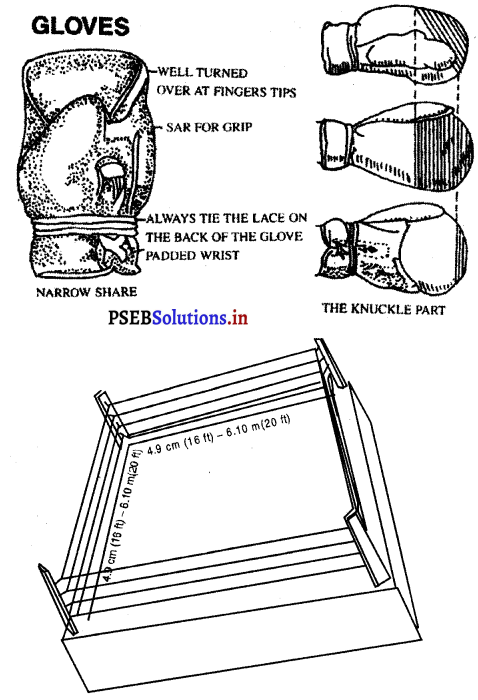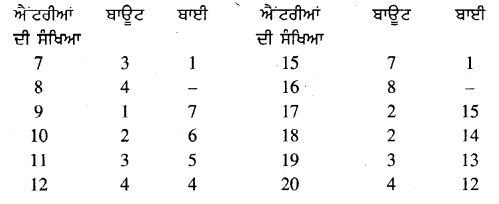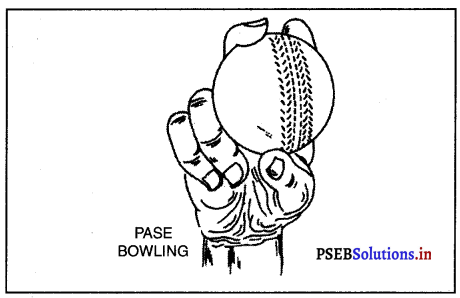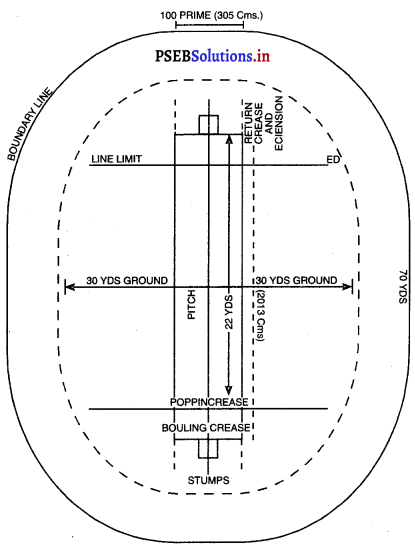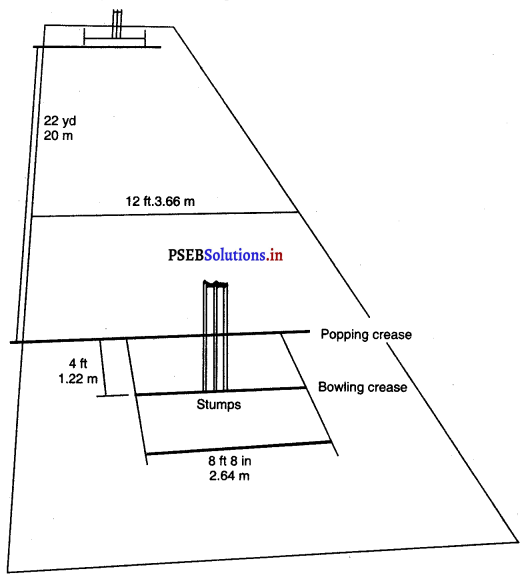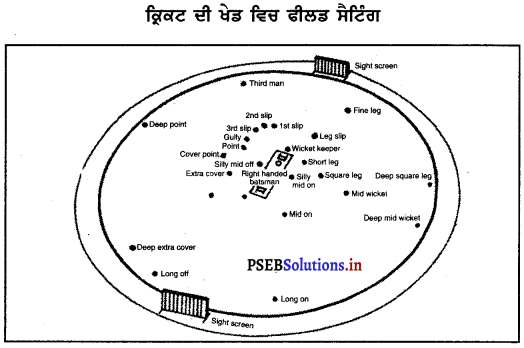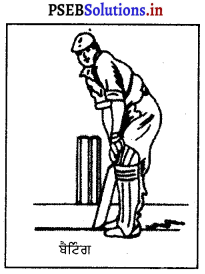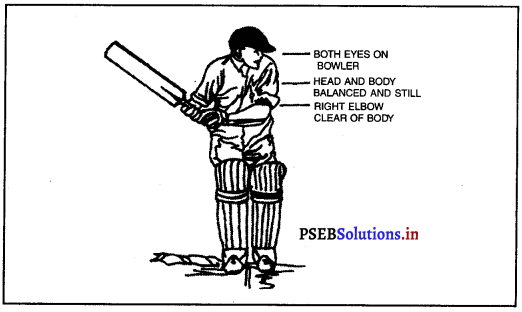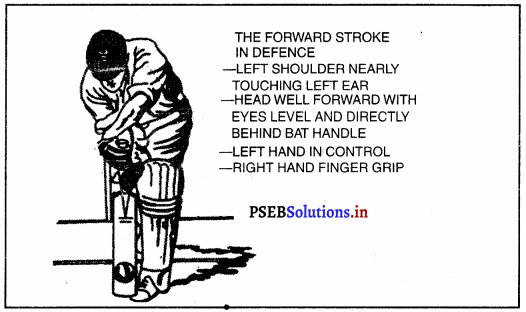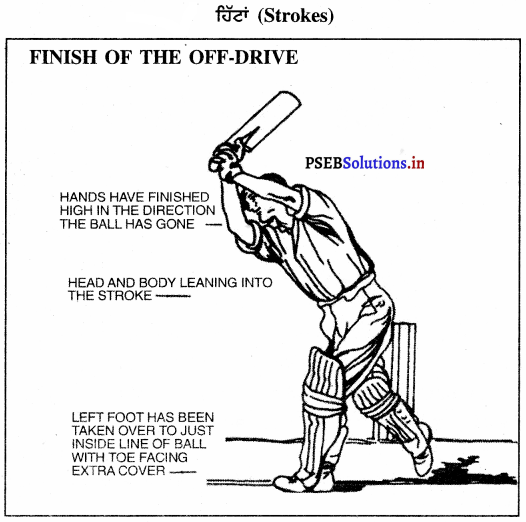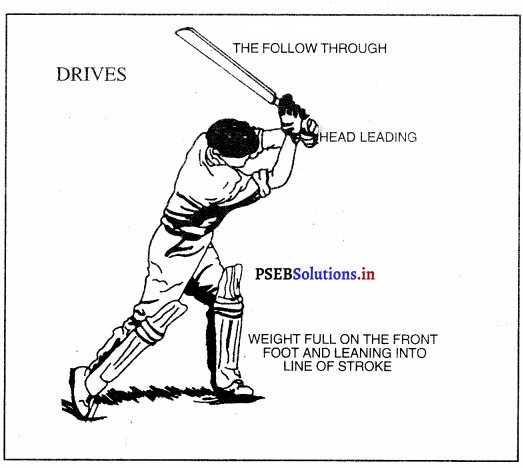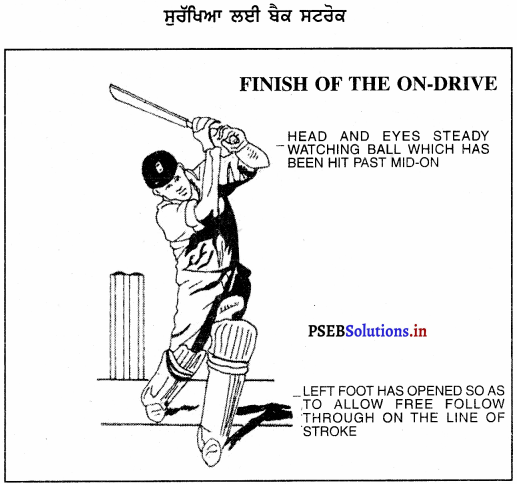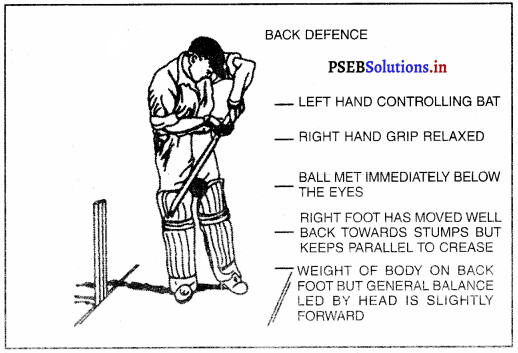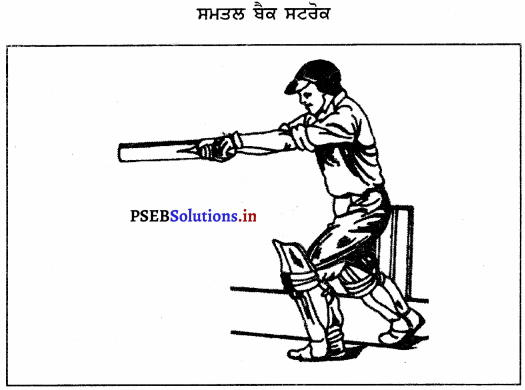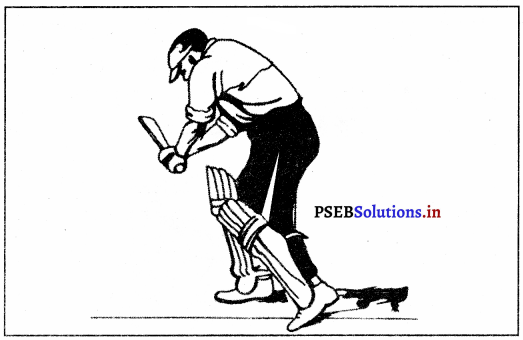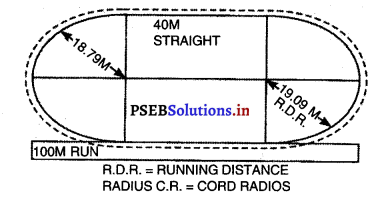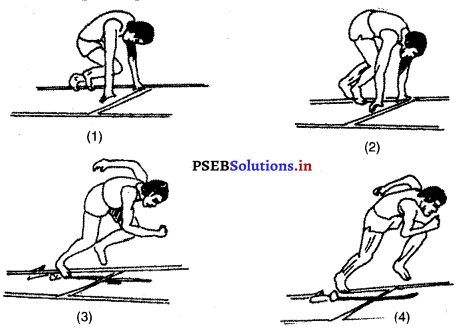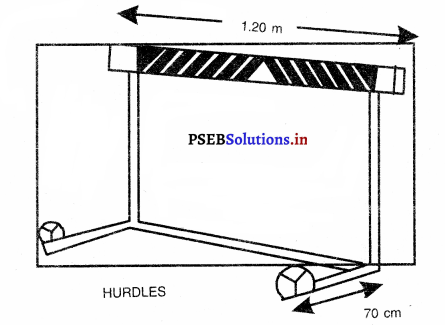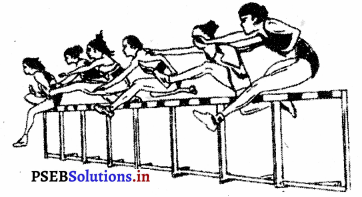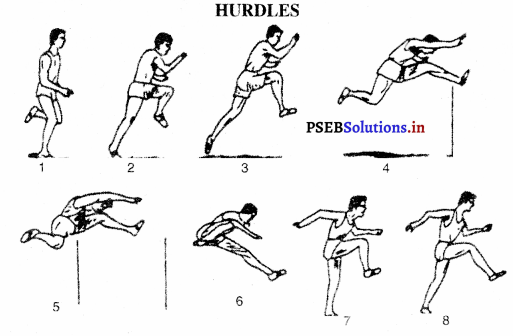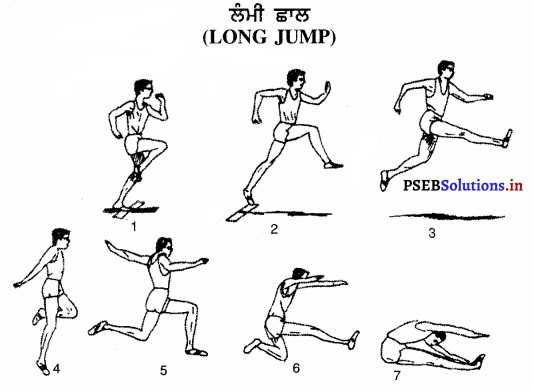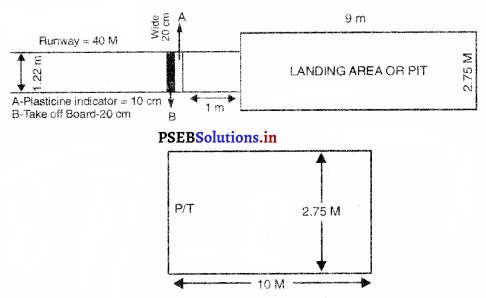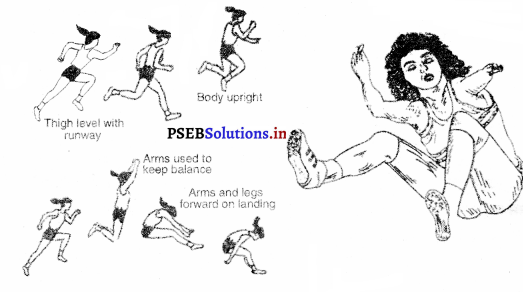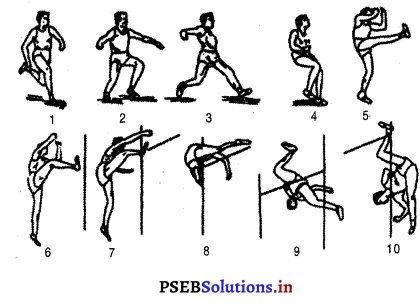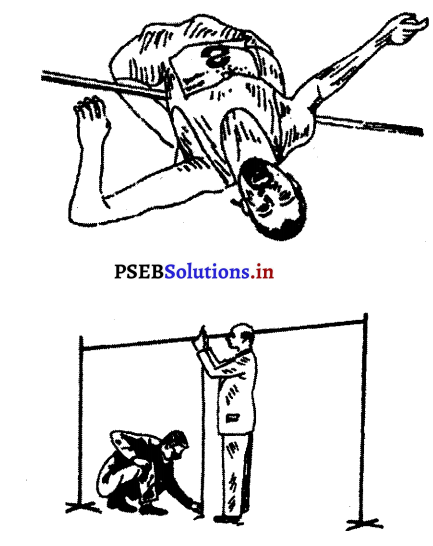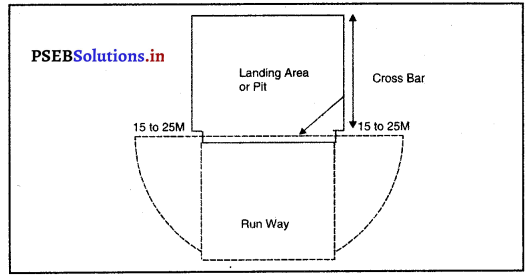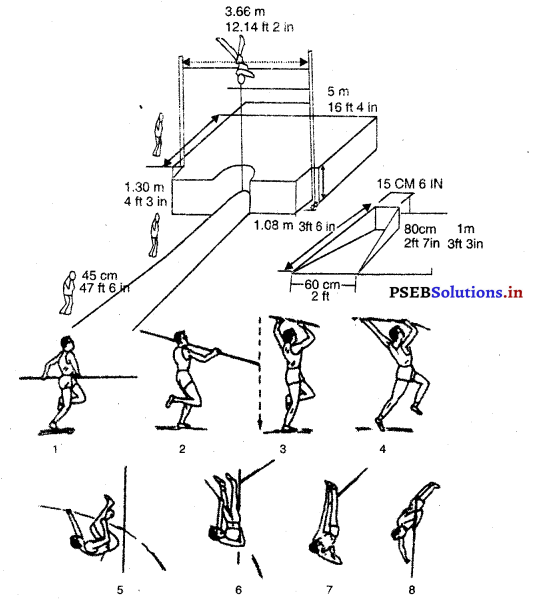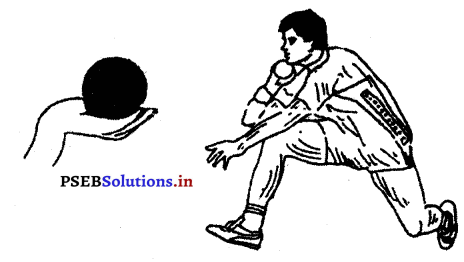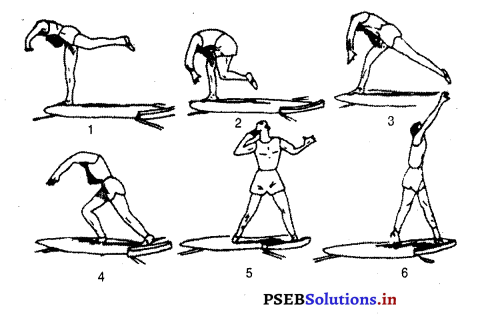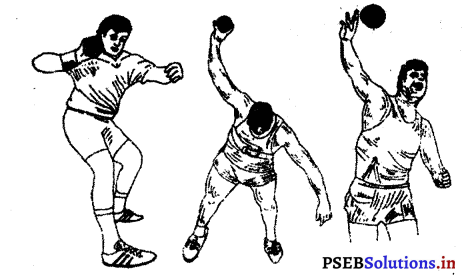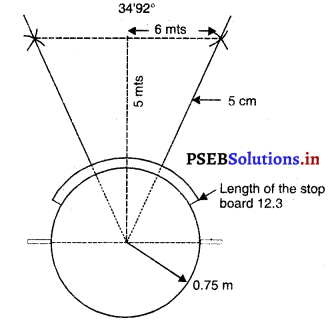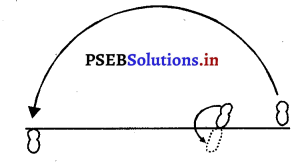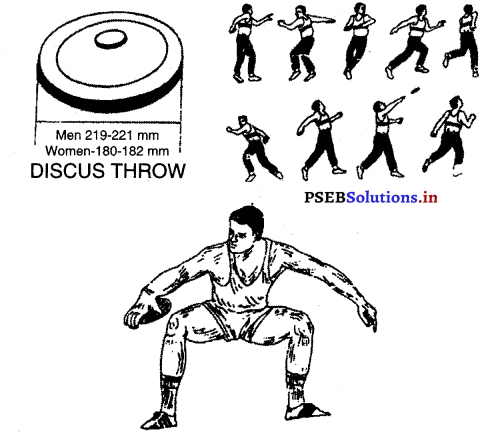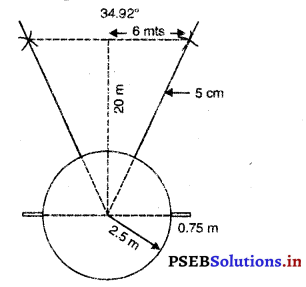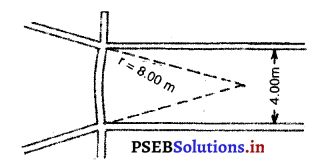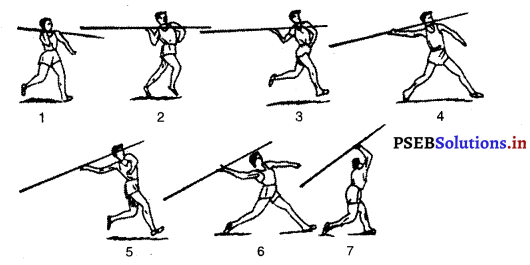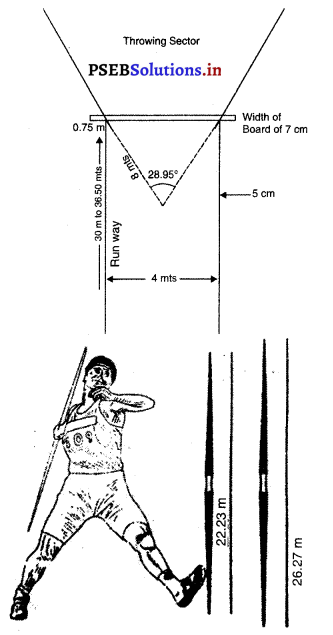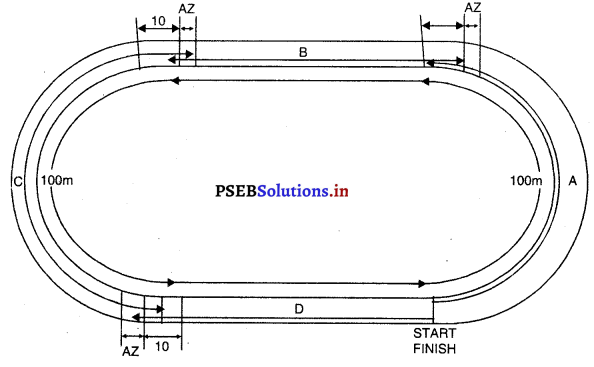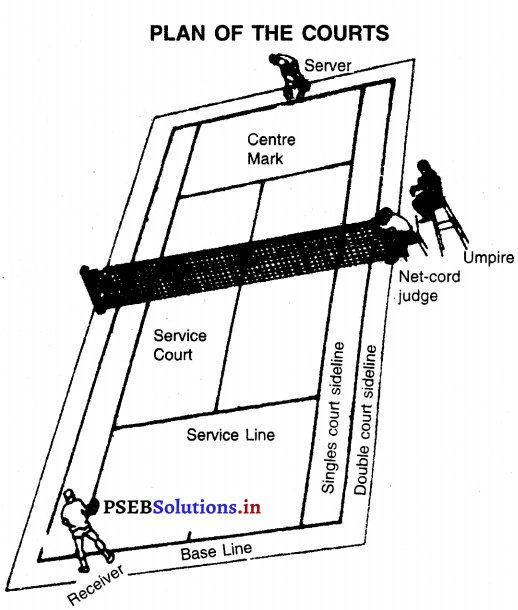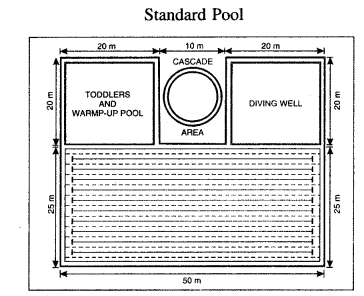Punjab State Board PSEB 10th Class Home Science Book Solutions Chapter 8 ਪਰਿਵਾਰ Textbook Exercise Questions and Answers.
PSEB Solutions for Class 10 Home Science Chapter 8 ਪਰਿਵਾਰ
Home Science Guide for Class 10 PSEB ਪਰਿਵਾਰ Textbook Questions and Answers
ਅਭਿਆਸ !
ਵਸਤੂਨਿਸ਼ਠ ਪ੍ਰਸ਼ਨ
ਪ੍ਰਸ਼ਨ 1.
ਪਰਿਵਾਰ ਤੋਂ ਤੁਸੀਂ ਕੀ ਸਮਝਦੇ ਹੋ ?
ਉੱਤਰ-
ਪਰਿਵਾਰ ਸਮਾਜ ਦੀ ਮੂਲ ਇਕਾਈ ਹੈ ਅਤੇ ਸਮਾਜਿਕ ਬਣਤਰ ਦਾ ਆਧਾਰ ਹੈ । ਪਰਿਵਾਰ ਉਹਨਾਂ ਲੋਕਾਂ ਦਾ ਇਕ ਸਮੂਹ ਹੈ ਜਿਨ੍ਹਾਂ ਦਾ ਆਪਸੀ ਖੂਨ ਜਾਂ ਕਾਨੂੰਨ ਦਾ ਸੰਬੰਧ ਹੋਵੇ, ਇਕ ਘਰ ਵਿਚ ਰਹਿੰਦੇ ਹੋਣ ਤੇ ਸਾਂਝਾ ਸਰਮਾਇਆ ਵਰਤਦੇ ਹੋਣ, ਇਕ-ਦੂਜੇ ਨਾਲ ਭਾਵਨਾਤਮਿਕ ਸਾਂਝ ਹੋਵੇ ਤੇ ਸਾਂਝੀਆਂ ਖੁਸ਼ੀਆਂ ਗਮੀਆਂ ਹੋਣ ਤੇ ਲੋੜ ਪੈਣ ‘ਤੇ ਇਕ-ਦੂਜੇ ਦੀ ਸਹਾਇਤਾ ਕਰਨ ।
ਪ੍ਰਸ਼ਨ 2.
ਸਮਾਜ ਦੀ ਬਣਤਰ ਦਾ ਆਧਾਰ ਕੀ ਹੈ ?
ਉੱਤਰ-
ਸਮਾਜ ਦੀ ਬਣਤਰ ਦਾ ਆਧਾਰ ਪਰਿਵਾਰ ਹੈ ਪਰਿਵਾਰ ਇਕ ਸਮਾਜ ਦੀ ਮੁੱਢਲੀ ਇਕਾਈ ਹੈ । ਪਰਿਵਾਰਾਂ ਨੂੰ ਮਿਲ ਕੇ ਹੀ ਇਕ ਸਮਾਜ ਜਨਮ ਲੈਂਦਾ ਹੈ ਆਦਮੀ ਪਰਿਵਾਰਾਂ ਰਾਹੀਂ ਸਮਾਜ ਨਾਲ ਜੁੜਦੇ ਹਨ ਤੇ ਸਮਾਜ ਵਿਚ ਰਹਿਣਾ ਸਿੱਖਦੇ ਹਨ । ਪਰਿਵਾਰ ਦੀ ਸੰਸਥਾ ਹੋਂਦ ਵਿਚ ਆਉਣ ਤੋਂ ਬਾਅਦ ਹੀ ਸਮਾਜ ਨੇ ਜਨਮ ਲਿਆ ਹੈ ।
ਪ੍ਰਸ਼ਨ 3.
ਪਰਿਵਾਰ ਦੀਆਂ ਮੁੱਖ ਕਿਸਮਾਂ ਕਿਹੜੀਆਂ ਹਨ ?
ਜਾਂ
ਪਰਿਵਾਰ ਦੀਆਂ ਕਿਸਮਾਂ ਦੱਸੋ ।
ਉੱਤਰ-
ਮੁੱਖ ਤੌਰ ‘ਤੇ ਪਰਿਵਾਰ ਦੀਆਂ ਦੋ ਕਿਸਮਾਂ ਹਨ
- ਸੰਯੁਕਤ ਪਰਿਵਾਰ -ਸੰਯੁਕਤ ਪਰਿਵਾਰ ਇਕ ਵੱਡਾ ਪਰਿਵਾਰ ਹੁੰਦਾ ਹੈ । ਸੰਖੇਪ ਵਿਚ ਜਿਸ ਘਰ ਵਿਚ ਤਿੰਨ ਪੀੜ੍ਹੀਆਂ ਦੇ ਮੈਂਬਰ ਇਕੱਠੇ ਇਕ ਘਰ ਵਿਚ ਰਹਿੰਦੇ ਹੋਣ ਤੇ ਪਰਿਵਾਰ ਦੇ ਸਾਧਨਾਂ ਨੂੰ ਸਾਂਝੇ ਰੂਪ ਵਿਚ ਵਰਤਦੇ ਹੋਣ, ਨੂੰ ਸੰਯੁਕਤ ਪਰਿਵਾਰ ਕਿਹਾ ਜਾਂਦਾ ਹੈ ।
- ਇਕਾਈ ਪਰਿਵਾਰ -ਇਹ ਪਰਿਵਾਰ ਛੋਟਾ ਪਰਿਵਾਰ ਹੁੰਦਾ ਹੈ । ਜਿਸ ਵਿਚ ਮਾਤਾ, ਪਿਤਾ ਤੇ ਉਨ੍ਹਾਂ ਦੇ ਬੱਚੇ ਰਹਿੰਦੇ ਹੋਣ, ਉਸ ਨੂੰ ਇਕਾਈ ਪਰਿਵਾਰ ਕਿਹਾ ਜਾਂਦਾ ਹੈ ।
ਛੋਟੇ ਉੱਤਰਾਂ ਵਾਲੇ ਪ੍ਰਸ਼ਨ
ਪ੍ਰਸ਼ਨ 4.
ਸੰਯੁਕਤ ਪਰਿਵਾਰ ਤੋਂ ਤੁਸੀਂ ਕੀ ਸਮਝਦੇ ਹੋ ?
ਉੱਤਰ-
ਸੰਯੁਕਤ ਪਰਿਵਾਰ ਇਕ ਵੱਡਾ ਪਰਿਵਾਰ ਹੁੰਦਾ ਹੈ ਜਿਸ ਵਿਚ ਮਾਂ-ਪਿਉ, ਉਹਨਾਂ ਦੇ ਬੱਚੇ ਤੇ ਪੋਤੇ-ਪੋਤੀਆਂ ਇਕੱਠੇ ਰਹਿੰਦੇ ਹਨ । ਇਸ ਪਰਿਵਾਰ ਵਿਚ ਸਾਰਿਆਂ ਦੀ ਸਾਂਝੀ ਕਮਾਈ ਹੁੰਦੀ ਹੈ ਅਤੇ ਘਰ ਦੇ ਸਾਰੇ ਮੈਂਬਰ ਉਸੇ ਕਮਾਈ ਵਿਚੋਂ ਆਪਣੀਆਂ ਲੋੜਾਂ ਦੀ ਪੂਰਤੀ ਕਰਦੇ ਹਨ । ਇਹ ਪਰਿਵਾਰ ਇਕ ਛੱਤ ਥੱਲੇ ਰਹਿੰਦਾ ਹੈ ਅਤੇ ਇਕ ਚੁੱਲ੍ਹੇ ‘ਤੇ ਰੋਟੀ ਖਾਂਦਾ ਹੈ । ਦੁੱਖਸੁਖ ਵਿਚ ਸਾਰੇ ਪਰਿਵਾਰ ਦੇ ਮੈਂਬਰ ਇਕੱਠੇ ਰਹਿੰਦੇ ਹਨ । ਪਰ ਅੱਜ-ਕਲ੍ਹ ਇਸ ਤਰ੍ਹਾਂ ਦੇ ਪਰਿਵਾਰ ਘੱਟਦੇ ਜਾ ਰਹੇ ਹਨ ।
![]()
ਪ੍ਰਸ਼ਨ 5.
ਇਕਾਈ (ਜਾਂ ਛੋਟਾ) ਪਰਿਵਾਰ ਤੋਂ ਤੁਸੀਂ ਕੀ ਸਮਝਦੇ ਹੋ ?
ਉੱਤਰ-
ਇਕਾਈ ਪਰਿਵਾਰ ਇਕ ਛੋਟਾ ਪਰਿਵਾਰ ਹੁੰਦਾ ਹੈ । ਇਕਾਈ ਪਰਿਵਾਰ ਵਿਚ ਮਾਂਬਾਪ ਤੇ ਉਹਨਾਂ ਦੀ ਸੰਤਾਨ ਇਕੱਠੇ ਰਹਿੰਦੇ ਹਨ । ਇਹ ਇਕ ਸੁਤੰਤਰ ਇਕਾਈ ਹੈ । ਪੱਛਮੀ ਦੇਸ਼ਾਂ ਦੀ ਤਰਜ਼ ਉੱਪਰ ਸਾਡੇ ਦੇਸ਼ ਵਿਚ ਵੀ ਇਕਾਈ ਪਰਿਵਾਰਾਂ ਦੀ ਗਿਣਤੀ ਵਧਦੀ ਜਾ ਰਹੀ ਹੈ । ਇਸ ਪਰਿਵਾਰ ਵਿੱਚ ਮਾਂ-ਬਾਪ ਦੀ ਆਮਦਨ ਇਸ ਘਰ ਵਿਚ ਕਮਾਈ ਦਾ ਸੋਮਾ ਹੁੰਦੀ ਹੈ। ਜਿਸਨੂੰ ਬੱਚੇ ਤੇ ਮਾਂ-ਬਾਪ ਰਲ ਕੇ ਖ਼ਰਚਦੇ ਹਨ । ਇਸ ਤਰਾਂ ਦੇ ਪਰਿਵਾਰਾਂ ਦੇ ਮੈਂਬਰਾਂ ਵਿਚ ਜਿੱਥੇ ਅਜ਼ਾਦੀ ਤੇ ਸਵੈ-ਵਿਸ਼ਵਾਸ ਦੀ ਭਾਵਨਾ ਵੱਧਦੀ ਹੈ, ਉੱਥੇ ਸੁਆਰਥ ਦੀ ਭਾਵਨਾ ਵੀ ਇਸ ਤਰ੍ਹਾਂ ਦੇ ਪਰਿਵਾਰ ਨੂੰ ਆਪਣੇ ਸਕੇ-ਸੰਬੰਧੀਆਂ ਨੂੰ ਇਹਨਾਂ ਨਾਲੋਂ ਦੂਰ ਕਰਦੀ ਹੈ ।
ਪ੍ਰਸ਼ਨ 6.
ਸੰਯੁਕਤ ਪਰਿਵਾਰ ਹੋਣ ਦਾ ਕੀ ਨੁਕਸਾਨ ਹੈ ?
ਉੱਤਰ-
ਅੱਜ-ਕਲ੍ਹ ਸੰਯੁਕਤ ਪਰਿਵਾਰਾਂ ਦੀ ਗਿਣਤੀ ਕਾਫ਼ੀ ਘੱਟਦੀ ਜਾਂਦੀ ਹੈ । ਸੰਯੁਕਤ ਪਰਿਵਾਰਾਂ ਦੇ ਕਈ ਫਾਇਦੇ ਤੇ ਕਈ ਨੁਕਸਾਨ ਹਨ । ਸੰਯੁਕਤ ਪਰਿਵਾਰ ਦੇ ਨੁਕਸਾਨ ਹੇਠ ਲਿਖੇ ਹਨ
ਨੁਕਸਾਨ-
- ਸੰਯੁਕਤ ਪਰਿਵਾਰ ਵਿਚ ਆਰਥਿਕ ਸੁਰੱਖਿਆ ਕਰਕੇ ਪਰਿਵਾਰ ਦੇ ਲਈ ਮੈਂਬਰ ਨਿਕੰਮੇ ਤੇ ਆਲਸੀ ਬਣ ਜਾਂਦੇ ਹਨ ।
- ਕਈ ਵਾਰ ਲਾਇਕ ਬੱਚਿਆਂ ਦੀ ਸ਼ਖ਼ਸੀਅਤ ਦਾ ਵਿਕਾਸ ਨਹੀਂ ਹੁੰਦਾ ਕਿਉਂਕਿ ਪਰਿਵਾਰ ਵਿਚ ਸਾਰਿਆਂ ਨੂੰ ਬਰਾਬਰ ਸਮਝਿਆ ਜਾਂਦਾ ਹੈ ।
- ਸੰਯੁਕਤ ਪਰਿਵਾਰਾਂ ਵਿਚ ਔਰਤਾਂ ਨੂੰ ਬਹੁਤ ਘੱਟ ਆਜ਼ਾਦੀ ਹੁੰਦੀ ਹੈ ।
- ਪਰਿਵਾਰ ਦੇ ਕਈ ਮੈਂਬਰਾਂ ਨੂੰ ਆਪਣੇ ਪੈਰ ਉੱਪਰ ਆਪ ਖੜਨ ਦਾ ਮੌਕਾ ਨਹੀਂ ਮਿਲਦਾ !
- ਸੰਯੁਕਤ ਪਰਿਵਾਰ ਵਿਚ ਆਰਥਿਕ ਆਜ਼ਾਦੀ ਘੱਟ ਹੁੰਦੀ ਹੈ ।
ਪ੍ਰਸ਼ਨ 7.
ਸੰਯੁਕਤ ਪਰਿਵਾਰ ਦੀ ਕੀ ਖਾਸੀਅਤ ਹੁੰਦੀ ਹੈ ?
ਜਾਂ
ਸੰਯੁਕਤ ਪਰਿਵਾਰ ਦੇ ਕੀ ਲਾਭ ਹਨ ?
ਉੱਤਰ-
- ਸੰਯੁਕਤ ਪਰਿਵਾਰ ਵਿਚ ਸਾਂਝੀ ਕਮਾਈ ਹੁੰਦੀ ਹੈ ਜੋ ਜ਼ਰੂਰਤ ਵੇਲੇ ਕੰਮ ਆਉਂਦੀ ਹੈ ।
- ਇਸ ਪਰਿਵਾਰ ਵਿਚ ਸਾਰੇ ਕੰਮ ਵੰਡੇ ਜਾਂਦੇ ਹਨ ਇਕ ਮੈਂਬਰ ਉੱਪਰ ਬੋਝ ਨਹੀਂ ਪੈਂਦਾ ।
- ਸਾਂਝੇ ਪਰਿਵਾਰ ਵਿਚ ਬਜ਼ੁਰਗ, ਵਿਧਵਾ, ਅੰਗਹੀਨ ਜਾਂ ਬੱਚਿਆਂ ਨੂੰ ਬਹੁਤ ਸਹਾਰਾ ਮਿਲਦਾ ਹੈ ।
- ਅੱਜ-ਕਲ ਮਾਂ-ਬਾਪ ਕੋਲ ਬੱਚਿਆਂ ਲਈ ਵਿਹਲ ਘੱਟ ਹੁੰਦਾ ਹੈ ਤੇ ਸਾਂਝੇ ਪਰਿਵਾਰ ਵਿਚ ਬੱਚੇ ਦਾਦਾ-ਦਾਦੀ ਕੋਲੋਂ ਬਹੁਤ ਕੁੱਝ ਸਿੱਖਦੇ ਹਨ ।
- ਸਾਂਝੇ ਪਰਿਵਾਰ ਦੇ ਮੈਂਬਰਾਂ ਵਿਚ ਸਹਿਯੋਗ ਤੇ ਕੁਰਬਾਨੀ ਦੀ ਭਾਵਨਾ ਵੱਧ ਹੁੰਦੀ ਹੈ ।
- ਸਾਂਝੇ ਪਰਿਵਾਰ ਵਿਚ ਇਕੱਠੇ ਰਹਿਣ ਨਾਲ ਪਰਿਵਾਰ ਦਾ ਖ਼ਰਚ ਘੱਟ ਜਾਂਦਾ ਹੈ ਤੇ ਬੱਚਤ ਵੱਧ ਜਾਂਦੀ ਹੈ ।
ਪ੍ਰਸ਼ਨ 8.
ਇਕਾਈ ਪਰਿਵਾਰ ਦੀ ਕੀ ਖਾਸੀਅਤ ਹੁੰਦੀ ਹੈ ?
ਉੱਤਰ-
ਉਦਯੋਗੀਕਰਨ ਤੇ ਸ਼ਹਿਰੀਕਰਨ ਨਾਲ ਇਕਾਈ ਪਰਿਵਾਰਾਂ ਦੀ ਗਿਣਤੀ ਵੱਧ ਰਹੀ ਹੈ । ਇਸ ਤਰ੍ਹਾਂ ਦੇ ਪਰਿਵਾਰਾਂ ਦੀਆਂ ਖ਼ਾਸ ਗੱਲਾਂ ਇਸ ਪ੍ਰਕਾਰ ਹਨ
- ਇਸ ਪਰਿਵਾਰ ਦੇ ਮੈਂਬਰ ਇਕ-ਦੂਜੇ ਦੇ ਵਧੇਰੇ ਨਜ਼ਦੀਕ ਹੁੰਦੇ ਹਨ ।
- ਇਸ ਪਰਿਵਾਰ ਵਿਚ ਆਰਥਿਕ ਸੁਤੰਤਰਤਾ ਹੁੰਦੀ ਹੈ । ਪਤੀ-ਪਤਨੀ ਆਪਣੀ ਮਰਜ਼ੀ ਨਾਲ ਖ਼ਰਚ ਕਰ ਸਕਦੇ ਹਨ ।
- ਇਸ ਪਰਿਵਾਰ ਨੂੰ ਇਕ ਜਾਂ ਦੋ ਬੰਦਿਆਂ ਦੀ ਕਮਾਈ ਉੱਪਰ ਹੀ ਗੁਜ਼ਾਰਾ ਕਰਨਾ ਪੈਂਦਾ ਹੈ ।
- ਇਸ ਤਰ੍ਹਾਂ ਦੇ ਪਰਿਵਾਰ ਇਕ ਘਰ ਦੇ ਕੰਮ ਦਾ ਸਾਰਾ ਬੋਝ ਹਿਣੀ ਦੇ ਉੱਪਰ ਹੀ ਪੈਂਦਾ ਹੈ ।
- ਇਸ ਪਰਿਵਾਰ ਦੇ ਮੈਂਬਰ ਵੱਡੇ-ਵਡੇਰਿਆਂ ਦੇ ਤਜਰਬੇ ਤੋਂ ਫਾਇਦਾ ਨਹੀਂ ਉਠਾ ਸਕਦੇ ।
ਪ੍ਰਸ਼ਨ 9.
ਛੋਟੇ ਪਰਿਵਾਰ ਦਾ ਕੀ ਮਹੱਤਵ ਹੈ ?
ਉੱਤਰ-
ਬੱਚੇ ਦੀ ਸਹੀ ਪਰਵਰਿਸ਼ ਲਈ ਪਰਿਵਾਰ ਦਾ ਛੋਟਾ ਹੋਣਾ ਜ਼ਰੂਰੀ ਹੈ । ਵੱਡੇ ਪਰਿਵਾਰਾਂ ਵਿਚ ਬੱਚੇ ਆਮ ਤੌਰ ‘ਤੇ ਥੁੜਾਂ ਦਾ ਹੀ ਸ਼ਿਕਾਰ ਰਹਿੰਦੇ ਹਨ ।
ਕਿਸੇ ਦੀਆਂ ਵੀ ਸਾਰੀਆਂ ਲੋੜਾਂ ਪੂਰੀਆਂ ਨਹੀਂ ਹੁੰਦੀਆਂ । ਇਸ ਲਈ ਪਰਿਵਾਰ ਦੀ ਖੁਸ਼ੀ ਲਈ ਹੇਠ ਲਿਖੇ ਕਾਰਨਾਂ ਕਰਕੇ ਪਰਿਵਾਰ ਛੋਟਾ ਹੋਣਾ ਚਾਹੀਦਾ ਹੈ ।
1. ਆਪਸੀ ਪਿਆਰ-ਛੋਟੇ ਪਰਿਵਾਰ ਵਿਚ ਆਪਸੀ ਪਿਆਰ ਦੀ ਭਾਵਨਾ ਵਧੇਰੇ ਦੇਖਣ ਨੂੰ ਮਿਲਦੀ ਹੈ।
2. ਆਰਥਿਕ ਵਿਕਾਸ-ਛੋਟੇ ਪਰਿਵਾਰ ਵਿਚ ਖ਼ਰਚ ਘੱਟ ਹੋਣ ਕਰਕੇ ਸਭ ਦੀਆਂ ਲੋੜਾਂ ਪੂਰੀਆਂ ਕਰਕੇ ਵੀ ਬੱਚਤ ਹੋ ਸਕਦੀ ਹੈ ਜਿਸ ਨਾਲ ਪਰਿਵਾਰ ਆਰਥਿਕ ਵਿਕਾਸ ਕਰਦਾ ਹੈ ।
3. ਸਰਬ-ਪੱਖੀ ਵਿਕਾਸ-ਛੋਟੇ ਪਰਿਵਾਰ ਵਿਚ ਮਾਂ-ਬਾਪ ਬੱਚਿਆਂ ਵਲ ਵਿਅਕਤੀਗਤ ਧਿਆਨ ਦੇ ਕੇ ਉਹਨਾਂ ਦੀਆਂ ਸਰੀਰਕ, ਮਾਨਸਿਕ ਤੇ ਆਰਥਿਕ ਲੋੜਾਂ ਪੂਰੀਆਂ ਕਰਕੇ ਉਹਨਾਂ ਦਾ ਸਰਬ-ਪੱਖੀ ਵਿਕਾਸ ਕਰ ਸਕਦੇ ਹਨ ।
4. ਬੱਚਿਆਂ ਦਾ ਆਤਮ-ਵਿਸ਼ਵਾਸ-ਬੱਚਿਆਂ ਦੀਆਂ ਲੋੜਾਂ ਪੂਰੀਆਂ ਹੋਣ ਕਰਕੇ ਉਹਨਾਂ ਦਾ ਸਰਬ-ਪੱਖੀ ਵਿਕਾਸ ਹੁੰਦਾ ਹੈ ਜਿਸ ਨਾਲ ਉਹਨਾਂ ਦਾ ਆਤਮ-ਵਿਸ਼ਵਾਸ ਵੱਧਦਾ ਹੈ !
5. ਆਬਾਦੀ ਵਿਚ ਘੱਟ ਵਾਧਾ-ਛੋਟੇ ਪਰਿਵਾਰ ਹੋਣ ਨਾਲ ਦੇਸ਼ ਦੀ ਆਬਾਦੀ ਵਿਚ ਘੱਟ ਵਾਧਾ ਹੁੰਦਾ ਹੈ । ਇਸ ਨਾਲ ਦੇਸ਼ ਦਾ ਆਰਥਿਕ ਵਿਕਾਸ ਤੇਜ਼ੀ ਨਾਲ ਹੁੰਦਾ ਹੈ ।
![]()
ਪ੍ਰਸ਼ਨ 10.
ਛੋਟੇ ਪਰਿਵਾਰ ਦੇ ਕੀ ਲਾਭ ਹਨ ?
ਉੱਤਰ-
ਇਸ ਪ੍ਰਸ਼ਨ ਦੇ ਉੱਤਰ ਲਈ ਪ੍ਰਸ਼ਨ ਨੰਬਰ 9 ਦਾ ਉੱਤਰ ਵੇਖੋ !
ਪ੍ਰਸ਼ਨ 11.
ਬੱਚਿਆਂ ਵਿਚ ਫਾਸਲਾ ਕਰਨ ਦਾ ਕੀ ਮਹੱਤਵ ਹੈ ?
ਉੱਤਰ-
ਛੋਟੇ ਪਰਿਵਾਰ ਦੇ ਹੋਣ ਦੇ ਨਾਲ-ਨਾਲ ਬੱਚਿਆਂ ਵਿਚ ਵਧੇਰੇ ਫਾਸਲਾ ਹੋਣਾ ਵੀ ਜ਼ਰੂਰੀ ਹੈ । ਕਿਉਂਕਿ ਗਰਭ ਸਮੇਂ ਮਾਂ ਨੂੰ ਚੰਗੇ ਭੋਜਨ ਦੀ ਜ਼ਰੂਰਤ ਹੁੰਦੀ ਹੈ ਜੇਕਰ ਭੋਜਨ ਵਿਚ ਕੈਲਸ਼ੀਅਮ, ਲੋਹਾ, ਪ੍ਰੋਟੀਨ, ਵਿਟਾਮਿਨ ਆਦਿ ਦੀ ਉੱਚਿਤ ਮਾਤਰਾ ਨਾ ਹੋਵੇ ਤਾਂ ਮਾਂ ਦੀ ਸਿਹਤ ਕਮਜ਼ੋਰ ਪੈ ਜਾਂਦੀ ਹੈ । ਇਸ ਦਾ ਅਸਰ ਬੱਚੇ ਦੀ ਸਿਹਤ ਉੱਪਰ ਵੀ ਪੈਂਦਾ ਹੈ । ਜੇਕਰ ਦੂਸਰਾ ਬੱਚਾ ਵੀ ਛੇਤੀ ਹੀ ਆ ਜਾਵੇ ਤਾਂ ਉਸ ਨਾਲ ਮਾਂ ਅਤੇ ਬੱਚੇ ਦੋਹਾਂ ਦੀ ਸਿਹਤ ਉੱਪਰ ਹੋਰ ਵੀ ਬੁਰਾ ਅਸਰ ਪਵੇਗਾ । ਇਸ ਤੋਂ ਇਲਾਵਾ ਫਾਸਲਾ ਘੱਟ ਹੋਣ ਦੀ ਸੂਰਤ ਵਿਚ ਮਾਂ ਲਈ ਦੋਵਾਂ ਬੱਚਿਆਂ ਨੂੰ ਸੰਭਾਲਣਾ ਹੋਰ ਵੀ ਔਖਾ ਹੁੰਦਾ ਹੈ । ਇਸ ਲਈ ਮਾਂ ਬੱਚੇ ਦੀ ਸਿਹਤ ਦਾ ਖ਼ਿਆਲ, ਬੱਚਿਆਂ ਦੀ ਸਹੀ ਦੇਖਭਾਲ ਤੇ ਆਰਥਿਕ ਤੱਤਾਂ ਨੂੰ ਧਿਆਨ ਵਿਚ ਰੱਖਦੇ ਹੋਏ ਇਹ ਕਹਿਣਾ ਬਿਲਕੁਲ ਠੀਕ ਹੈ ਦੋ ਬੱਚਿਆਂ ਵਿਚਕਾਰ ਘੱਟੋ ਘੱਟ ਤਿੰਨ ਸਾਲ ਦਾ ਫਾਸਲਾ ਜ਼ਰੂਰ ਚਾਹੀਦਾ ਹੈ ।
ਨਿਬੰਧਾਤਮਕ ਪ੍ਰਸ਼ਨ
ਪ੍ਰਸ਼ਨ 12.
ਸੰਯੁਕਤ ਤੇ ਇਕਾਈ ਪਰਿਵਾਰ ਦੀ ਤੁਲਨਾ ਕਰੋ ਅਤੇ ਦੋਨਾਂ ਦੇ ਫਾਇਦੇ ਅਤੇ ਨੁਕਸਾਨ ਦੱਸੋ ।
ਉੱਤਰ –
| ਸੰਯੁਕਤ ਪਰਿਵਾਰ | ਇਕਾਈ ਪਰਿਵਾਰ |
| 1. ਇਹ ਪਰਿਵਾਰ ਵੱਡਾ ਹੁੰਦਾ ਹੈ । | 1. ਇਹ ਪਰਿਵਾਰ ਛੋਟਾ ਹੁੰਦਾ ਹੈ । |
| 2. ਇਸ ਪਰਿਵਾਰ ਵਿਚ ਕਮਾਈ ਸਾਂਝੀ ਦੀ ਜਾਂ ਮਾਂ ਦੀ ਹੁੰਦੀ ਹੈ । | 2. ਇਸ ਪਰਿਵਾਰ ਵਿਚ ਕਮਾਈ ਸਿਰਫ਼ ਪਿਤਾ ਹੁੰਦੀ ਹੈ । |
| 3. ਇਸ ਪਰਿਵਾਰ ਵਿਚ ਇਕੱਠੇ ਰਹਿਣ ਵਿਚ ਖ਼ਰਚ ਘੱਟ ਹੁੰਦਾ ਹੈ । | 3. ਇਸ ਪਰਿਵਾਰ ਦੇ ਮੁੱਢਲੇ ਖ਼ਰਚੇ ਜ਼ਿਆਦਾ ਵਿਚ ਖ਼ਰਚ ਘੱਟ ਹੁੰਦਾ ਹੈ । |
| 4. ਇਸ ਪਰਿਵਾਰ ਵਿਚ ਕੰਮ ਵੰਡਿਆ ਹੋਣ ਕਰਕੇ ਹਿਣੀਆਂ ਨੂੰ ਕੁੱਝ ਵਿਹਲ ਮਿਲ ਜਾਂਦੀ ਹੈ । | 4. ਇਸ ਪਰਿਵਾਰ ਵਿਚ ਘਰ ਦਾ ਸਾਰਾ ਕੰਮ ਹਿਣੀ ਨੂੰ ਕਰਨਾ ਪੈਂਦਾ ਹੈ । |
| 5. ਇਸ ਪਰਿਵਾਰ ਦੇ ਬੱਚੇ ਦਾਦਾ-ਦਾਦੀ ਤੋਂ ਬਹੁਤ ਕੁੱਝ ਸਿੱਖਦੇ ਹਨ । | 5. ਇਸ ਪਰਿਵਾਰ ਦੇ ਬੱਚੇ ਦਾਦਾ-ਦਾਦੀ ਦੇ ਪਿਆਰ ਤੋਂ ਵਾਂਝੇ ਰਹਿ ਜਾਂਦੇ ਹਨ। |
| 6. ਇਸ ਪਰਿਵਾਰ ਵਿਚ ਆਰਥਿਕ ਸੁਤੰਤਰਤਾ ਘੱਟ ਹੁੰਦੀ ਹੈ । ਸਾਰੇ ਮੈਂਬਰ ਘਰ ਦੇ ਮੁਖੀ ਤੋਂ ਪੈਸੇ ਲੈ ਕੇ ਖ਼ਰਚਦੇ ਹਨ । | 6. ਇਸ ਪਰਿਵਾਰ ਵਿਚ ਪਤੀ-ਪਤਨੀ ਆਰਥਿਕ ਤੌਰ ‘ਤੇ ਸੁਤੰਤਰ ਰਹਿੰਦੇ ਹਨ । |
ਸੰਯੁਕਤ ਤੇ ਇਕਾਈ ਪਰਿਵਾਰ ਦੇ ਲਾਭ-ਇਸ ਦੇ ਉੱਤਰ ਲਈ ਪ੍ਰਸ਼ਨ ਨੰ: 7 ਤੇ 8 ਦਾ ਉੱਤਰ ਲਿਖੋ ।
ਪ੍ਰਸ਼ਨ 13.
(i) ਬੱਚਿਆਂ ਵਿਚ ਫਾਸਲਾ ਕਰਨ ਨਾਲ ਪਰਿਵਾਰ ਵਿਚ ਆਰਥਿਕ ਖ਼ੁਸ਼ਹਾਲੀ ਆਉਂਦੀ ਹੈ । ਇਸ ਤੱਥ ਦੀ ਪੁਸ਼ਟੀ ਕਰੋ ।
ਜਾਂ
ਬੱਚਿਆਂ ਵਿਚ ਫਾਸਲਾ ਕਰਨ ਦਾ ਕੀ ਮਹੱਤਵ ਹੈ ? ਵਿਸਥਾਰ ਨਾਲ ਲਿਖੋ ।
(ii) ਆਰਥਿਕ ਖ਼ੁਸ਼ਹਾਲੀ ਲਈ ਛੋਟਾ ਪਰਿਵਾਰ ਅਤੇ ਬੱਚਿਆਂ ਵਿਚ ਫਾਸਲਾ ਹੋਣਾ ਕਿਉਂ ਜ਼ਰੂਰੀ ਹੈ ?
(iii) ਛੋਟੇ ਪਰਿਵਾਰ ਵਿੱਚ ਆਪਸੀ ਪਿਆਰ ਕਿਸ ਤਰ੍ਹਾਂ ਵਧਦਾ ਹੈ ਅਤੇ ਇਸ ਦਾ ਸਮੁੱਚੇ ਪਰਿਵਾਰ ਦੀ ਸਿਹਤ ‘ਤੇ ਕੀ ਅਸਰ ਪੈਂਦਾ ਹੈ ?
ਉੱਤਰ-
ਬੱਚਿਆਂ ਦੇ ਜਨਮ ਵਿਚਕਾਰ ਲੋੜੀਂਦਾ ਫਾਸਲਾ ਹੋਣਾ ਬਹੁਤ ਜ਼ਰੂਰੀ ਹੈ | ਮਾਹਿਰਾਂ ਅਨੁਸਾਰ ਇਕ ਬੱਚੇ ਤੇ ਦੁਸਰੇ ਬੱਚੇ ਦੇ ਜਨਮ ਵਿਚ ਘੱਟੋ-ਘੱਟ ਤਿੰਨ ਸਾਲ ਦਾ ਫਾਸਲਾ ਹੋਣਾ ਮਾਂ ਤੇ ਬੱਚੇ ਦੀ ਸਿਹਤ ਤੇ ਘਰ ਦੀ ਖ਼ੁਸ਼ਹਾਲੀ ਲਈ ਹੋਰ ਵੀ ਜ਼ਰੂਰੀ ਹੈ ।
(i) ਬੱਚਿਆਂ ਦੇ ਜਨਮ ਵਿਚ ਫਾਸਲਾ ਕਰਨ ਦਾ ਮਹੱਤਵ-
ਛੋਟਾ ਪਰਿਵਾਰ ਹੋਣ ਦੇ ਨਾਲ-ਨਾਲ ਬੱਚਿਆਂ ਵਿਚ ਵਧੇਰੇ ਫਾਸਲਾ ਹੋਣਾ ਵੀ ਜ਼ਰੂਰੀ ਹੈ ਕਿਉਂਕਿ ਗਰਭ ਦੇ ਸਮੇਂ ਮਾਂ ਨੂੰ ਚੰਗੇ ਭੋਜਨ ਦੀ ਜ਼ਰੂਰਤ ਹੁੰਦੀ ਹੈ । ਜੇਕਰ ਭੋਜਨ ਵਿਚ ਪ੍ਰੋਟੀਨ, ਕੈਲਸ਼ੀਅਮ ਅਤੇ ਲੋਹੇ ਦੀ ਉੱਚਿਤ ਮਾਤਰਾ ਨਾ ਹੋਵੇ ਤਾਂ ਬੱਚਾ ਮਾਂ ਦੇ ਸਰੀਰ ਤੋਂ ਹੀ ਇਨ੍ਹਾਂ ਪਦਾਰਥਾਂ ਨੂੰ ਹਾਸਲ ਕਰਦਾ ਹੈ ਜਿਸ ਕਾਰਨ ਮਾਂ ਵਿਚ ਇਨ੍ਹਾਂ ਤੱਤਾਂ ਦੀ ਘਾਟ ਹੋ ਜਾਂਦੀ ਹੈ । ਜੇਕਰ ਬੱਚਿਆਂ ਵਿਚ ਫਾਸਲਾ ਘੱਟ ਹੋਵੇ ਤਾਂ ਮਾਂ ਵਿਚ ਇਨ੍ਹਾਂ ਤੱਤਾਂ ਦੀ ਘਾਟ ਪੂਰੀ ਨਹੀਂ ਹੋ ਸਕਦੀ ਅਤੇ ਉਹ ਬਹੁਤ ਕਮਜ਼ੋਰ ਹੋ ਜਾਂਦੀ ਹੈ । ਇਸ ਦਾ ਬੱਚੇ ‘ਤੇ ਵੀ ਬੁਰਾ ਅਸਰ ਪੈਂਦਾ ਹੈ । ਉੱਤੋਂ ਥਲੀ ਦੋ ਬੱਚੇ ਹੋਣ ਕਾਰਨ ਜਨਮ ਤੋਂ ਬਾਅਦ ਵੀ ਮਾਂ ਬੱਚੇ ਵਲ ਪੂਰਾ ਸਮਾਂ ਅਤੇ ਧਿਆਨ ਨਹੀਂ ਦੇ ਸਕਦੀ ਜਿਸ ਕਾਰਨ ਬੱਚਿਆਂ ਦੀ ਠੀਕ ਦੇਖ-ਭਾਲ ਨਹੀਂ ਹੁੰਦੀ ।
ਇਸ ਲਈ ਬੱਚਿਆਂ ਵਿਚ ਫਾਸਲਾ ਕਰਨ ਦਾ ਮਹੱਤਵ ਹੇਠ ਲਿਖੇ ਅਨੁਸਾਰ ਹੈ –
- ਲਿੰਗ ਸੰਬੰਧੀ ਸੰਤੁਸ਼ਟੀ-ਪਰਿਵਾਰ ਵਿਚ ਮਾਂ-ਬਾਪ ਦੀ ਮਾਨਸਿਕ ਸ਼ਾਂਤੀ ਬਹੁਤ ਜ਼ਰੂਰੀ ਹੈ ਜਿਸ ਦਾ ਕਾਫ਼ੀ ਸੰਬੰਧ ਲਿੰਗ ਭਾਵਨਾ ਦੀ ਸੰਤੁਸ਼ਟੀ ਨਾਲ ਜੁੜਿਆ ਹੋਇਆ ਹੈ । ਵਧੇਰੇ ਬੱਚਿਆਂ ਦਾ ਭਾਰ ਮਾਂ-ਬਾਪ ਨੂੰ ਬੱਚਿਆਂ ਨਾਲ ਹੀ ਉਲਝਾਈ ਰੱਖਦਾ ਹੈ ਜਿਸ ਨਾਲ ਉਹਨਾਂ ਦੀ ਆਪਣੀ ਲਿੰਗ ਭੁੱਖ ਦੀ ਪੂਰਤੀ ਠੀਕ ਢੰਗ ਨਾਲ ਨਹੀਂ ਹੋ ਸਕਦੀ । ਉਹ ਚਿੜਚਿੜੇ ਜਿਹੇ ਬਣ ਜਾਂਦੇ ਹਨ ।
- ਬੱਚਿਆਂ ਦੀ ਸਹੀ ਦੇਖਭਾਲ-ਜੇ ਬੱਚਿਆਂ ਵਿਚ ਫਾਸਲਾ ਹੋਵੇਗਾ ਤਾਂ ਉਹਨਾਂ ਦਾ ਪਾਲਣ-ਪੋਸ਼ਣ ਸਹੀ ਢੰਗ ਨਾਲ ਹੋ ਸਕੇਗਾ ਅਤੇ ਉਹ ਹਰ ਪੱਖੋਂ ਵਿਕਸਿਤ ਹੋਣਗੇ ਅਤੇ ਉਹਨਾਂ ਦੀ ਸਿਹਤ ਵੀ ਚੰਗੀ ਹੋਵੇਗੀ ।
- ਆਰਥਿਕ ਤੌਰ ‘ਤੇ ਖ਼ੁਸ਼ਹਾਲ-ਫਾਸਲੇ ਨਾਲ ਬੱਚੇ ਹੋਣ ਸਮੇਂ ਆਰਥਿਕ ਮੁਸ਼ਕਿਲ ਘੱਟ ਆਉਂਦੀ ਹੈ ਕਿਉਂਕਿ ਫ਼ਾਸਲੇ ਦੌਰਾਨ ਬਚਾਇਆ ਪੈਸਾ ਅਗਲੇ ਬੱਚੇ ਲਈ ਵਰਤਿਆ ਜਾ ਸਕਦਾ ਹੈ ਅਤੇ ਕੁੱਝ ਪੈਸਾ ਘਰ ਦੀ ਖੁਸ਼ਹਾਲੀ ਲਈ ਵੀ ਵਰਤਿਆ ਜਾ ਸਕਦਾ ਹੈ ।
- ਮਨੋਰੰਜਨ ਦੀ ਪੂਰਤੀ-ਖੇਡ ਬੱਚਿਆਂ ਲਈ ਬਹੁਤ ਜ਼ਰੂਰੀ ਹੈ । ਜੇ ਬੱਚਿਆਂ ਵਿਚ ਫਾਸਲਾ ਹੋਵੇਗਾ ਤਾਂ ਮਾਂ-ਬਾਪ ਉਹਨਾਂ ਨਾਲ ਮਨੋਰੰਜਨ ਕਰ ਸਕਣਗੇ । ਉਹਨਾਂ ਨਾਲ ਥੋੜ੍ਹਾ ਬਹੁਤ ਖੇਡ ਸਕਣਗੇ, ਟੀ. ਵੀ. ਦੇਖ ਸਕਣਗੇ ਜਾਂ ਪਾਰਕ ਵਗੈਰਾ ਵੀ ਜਾ ਸਕਦੇ ਹਨ । ਇਸ ਤਰ੍ਹਾਂ ਦੋਵਾਂ ਦਾ ਹੀ ਮਨੋਰੰਜਨ ਹੋਵੇਗਾ ।
- ਮਾਂ-ਬਾਪ ਲਈ ਵਧੇਰੇ ਸਮਾਂ-ਉੱਤੋਂ ਥਲੀ ਬੱਚੇ ਹੋਣ ਨਾਲ ਮਾਂ-ਬਾਪ ਬੱਚਿਆਂ ਨਾਲ ਹੀ ਉਲਝੇ ਰਹਿੰਦੇ ਹਨ ਪਰ ਜੇ ਬੱਚਿਆਂ ਵਿਚ ਫ਼ਾਸਲਾ ਹੋਵੇਗਾ ਤਾਂ ਮਾਂ-ਬਾਪ ਕੋਲ ਵੀ ਹੋਰ ਰੁਝੇਵਿਆਂ ਲਈ ਸਮਾਂ ਮਿਲ ਸਕੇਗਾ ।
- ਮੌਤ ਦਰ ਵਿਚ ਘਾਟਾ-ਬੱਚਿਆਂ ਵਿਚ ਫਾਸਲਾ ਰੱਖਣ ਨਾਲ ਉਹਨਾਂ ਦੀ ਦੇਖਭਾਲ ਚੰਗੀ ਹੋਵੇਗੀ ਜਿਸ ਕਾਰਨ ਸਿਹਤ ਵੀ ਚੰਗੀ ਹੋਵੇਗੀ ਤੇ ਇਸ ਤਰ੍ਹਾਂ ਬੱਚਿਆਂ ਦੀ ਮੌਤ ਦਰ ਵਿਚ ਕਮੀ ਆਵੇਗੀ । ਅੱਜ-ਕਲ੍ਹ ਹਰ ਇਸਤਰੀ, ਪੁਰਸ਼ ਆਪਣੇ ਬੱਚਿਆਂ ਨੂੰ ਚੰਗੀ ਸਿੱਖਿਆ ਅਤੇ ਵਿਕਾਸ ਦੇ ਮੌਕੇ ਦੇਣਾ ਚਾਹੁੰਦਾ ਹੈ, ਇਸ ਲਈ ਪਰਿਵਾਰ ਨਿਯੋਜਿਤ ਕਰਨਾ ਬਹੁਤ ਜ਼ਰੂਰੀ ਹੋ ਗਿਆ ਹੈ ।
(ii) ਛੋਟਾ ਪਰਿਵਾਰ ਅਤੇ ਆਰਥਿਕ ਖ਼ੁਸ਼ਹਾਲੀ –
ਅੱਜ-ਕਲ੍ਹ ਮਹਿੰਗਾਈ ਦੇ ਜ਼ਮਾਨੇ ਵਿਚ ਪਰਿਵਾਰ ਦੀ ਆਰਥਿਕ ਖ਼ੁਸ਼ਹਾਲੀ ਦਾ ਪਰਿਵਾਰ ਦੇ ਸਾਈਜ਼ ਨਾਲ ਸਿੱਧਾ ਸੰਬੰਧ ਹੈ | ਘਰ ਦੀਆਂ ਬਹੁਤ ਸਾਰੀਆਂ ਸਮੱਸਿਆਵਾਂ ਪਰਿਵਾਰ ਦੇ ਛੋਟਾ ਹੋਣ ਨਾਲ ਹੀ ਹੱਲ ਹੋ ਸਕਦੀਆਂ ਹਨ । ਬੱਚਿਆਂ ਦੀ ਸਹੀ ਸਾਂਭ-ਸੰਭਾਲ ਲਈ ਜ਼ਰੂਰੀ ਹੋ ਜਾਂਦਾ ਹੈ ਕਿ ਪਰਿਵਾਰ ਛੋਟਾ ਹੋਵੇ । ਕਿਸੇ ਕੋਲ ਇੰਨਾ ਸਮਾਂ ਅਤੇ ਪੈਸਾ ਨਹੀਂ ਕਿ ਬਹੁਤ ਸਾਰੇ ਬੱਚਿਆਂ ਦੀ ਸਾਂਭ-ਸੰਭਾਲ ਕਰ ਸਕੇ । ਉਂਝ ਵੀ ਸੰਸਾਰ ਵਿਚ ਹਰ ਵਸਤੂ ਦੀ ਥੁੜ੍ਹ ਹੁੰਦੀ ਜਾ ਰਹੀ ਹੈ ਅਤੇ ਭਾਰਤ ਵਰਗੇ ਦੇਸ਼ ਵਿਚ ਤਾਂ | ਵੱਡੇ ਪਰਿਵਾਰਾਂ ਦੀ ਲੋੜ ਨਹੀਂ ਜਿੱਥੇ ਹਜ਼ਾਰਾਂ ਸਮੱਸਿਆਵਾਂ ਕੇਵਲ ਅਬਾਦੀ ਦੇ ਵਾਧੇ ਨਾਲ ਹੀ | ਜੁੜੀਆਂ ਹੋਈਆਂ ਹਨ । ਇਸ ਲਈ ਬੱਚਿਆਂ ਦੇ ਸਰਬ-ਪੱਖੀ ਵਿਕਾਸ ਲਈ ਪਰਿਵਾਰ ਛੋਟੇ ਤੋਂ ਛੋਟਾ ਹੋਵੇ ਤਾਂ ਜੋ | ਬੱਚੇ ਸਹੀ ਢੰਗ ਨਾਲ ਪਲ ਕੇ ਵੱਡੇ ਹੋਣ ਅਤੇ ਠੀਕ ਜੀਵਨ ਬਿਤਾ ਸਕਣ ਵੱਡੇ ਪਰਿਵਾਰਾਂ ਵਿਚ ਜ਼ਿਆਦਾ ਬੱਚੇ ਦਾ ਭੁੱਖ-ਨੰਗ ਦਾ ਸ਼ਿਕਾਰ ਹੀ ਰਹਿੰਦੇ ਹਨ । ਇਸੇ ਲਈ ਸਾਡੀ ਸਰਕਾਰ | ਅਤੇ ਸਮਾਜ ਛੋਟੇ ਪਰਿਵਾਰ ਦਾ ਨਾਅਰਾ ਲਾ ਰਹੀ ਹੈ।
ਹੇਠ ਲਿਖੇ ਕਾਰਨਾਂ ਕਰਕੇ ਪਰਿਵਾਰ ਛੋਟਾ ਚਾਹੀਦਾ ਹੈ –
ਆਪਸੀ ਪਿਆਰ-ਛੋਟੇ ਪਰਿਵਾਰ ਵਿਚ ਆਪਸੀ ਪ੍ਰੇਮ ਭਾਵਨਾ ਵਧੇਰੇ ਹੁੰਦੀ ਹੈ ਕਿਉਂਕਿ | ਥੋੜੇ ਬੱਚੇ ਰਲ ਕੇ ਮਾਤਾ-ਪਿਤਾ ਪਾਸ ਬੈਠ ਸਕਦੇ ਹਨ । ਇਸ ਤਰ੍ਹਾਂ ਇੱਕ-ਦੂਜੇ ਦਾ ਪਿਆਰ | ਅਤੇ ਸਤਿਕਾਰ ਲੈ ਸਕਦੇ ਹਨ ।
ਆਰਥਿਕ ਵਿਕਾਸ-ਬੱਚੇ ਘੱਟ ਹੋਣ ਨਾਲ ਉਹਨਾਂ ਦੀਆਂ ਲਗਪਗ ਸਾਰੀਆਂ ਲੋੜਾਂ ਆਸਾਨੀ ਨਾਲ ਪੂਰੀਆਂ ਹੋ ਜਾਂਦੀਆਂ ਹਨ । ਇਸ ਤਰ੍ਹਾਂ ਹਰ ਪ੍ਰਕਾਰ ਦਾ ਖ਼ਰਚ ਕੀਤਾ ਜਾ | ਸਕਦਾ ਹੈ ਅਤੇ ਕੁੱਝ ਪੈਸੇ ਬਚਾਏ ਵੀ ਜਾ ਸਕਦੇ ਹਨ ।
ਸਰਬ-ਪੱਖੀ ਵਿਕਾਸ -ਛੋਟੇ ਪਰਿਵਾਰ ਵਿਚ ਮਾਂ-ਬਾਪ ਹਰ ਬੱਚੇ ਵੱਲ ਵਿਅਕਤੀਗਤ ਧਿਆਨ ਦੇ ਕੇ ਉਹਨਾਂ ਦੀਆਂ ਸਰੀਰਕ, ਮਾਨਸਿਕ, ਆਰਥਿਕ ਤੇ| ਅਧਿਆਤਮਿਕ ਲੋੜਾਂ ਪੂਰੀਆਂ ਕਰਕੇ ਉਹਨਾਂ ਦਾ ਸਰਬ-ਪੱਖੀ ਵਿਕਾਸ ਕਰ ਸਕਦੇ ਹਨ । ਬੱਚਿਆਂ ਨੂੰ ਚੰਗੀ ਅਤੇ ਉੱਚ ਸਿੱਖਿਆ ਦਿੱਤੀ ਜਾ ਸਕਦੀ ਹੈ । ਅੱਜ-ਕਲ੍ਹ ਸਕੂਲ ਵਿਚ ਦਾਖਲਾ ਲੈਣ ਤੋਂ ਲੈ ਕੇ ਬੱਚਿਆਂ ਦੀ ਨੌਕਰੀ ਲਗਾਉਣ ਤਕ ਬਹੁਤ ਪ੍ਰਹਿਲ ਪ੍ਰਕਾਬਲਾ ਹੁੰਦਾ ਹੈ ਜਿਸ ਲਈ ਜ਼ਿਆਦਾ ਧਿਆਨ ਦੀ ਲੋੜ ਹੁੰਦੀ ਹੈ, ਜਿਹੜਾ ਕਿ ਵੱਡੇ ਪਰਿਵਾਰ ਵਾਲੇ ਘਰ ਵਿਚ ਮਾਂ ਨਹੀਂ ਦੇ ਸਕਦੀ |
ਕਰਨ ਉਪਰੰਤ ਕੁੱਝ ਪੈਸੇ ਬਚਾਏ ਜਾ ਸਕਦੇ ਹਨ ਜਿਸ ਨਾਲ ਬਜ਼ਾਰ ਵਿਚ ਜੋ ਕਈ ਤਰ੍ਹਾਂ ਦੀਆਂ ਚੀਜ਼ਾਂ ਮਿਲਦੀਆਂ ਹਨ ਉਹਨਾਂ ਨੂੰ ਹਾਸਲ ਕੀਤਾ ਜਾ ਸਕਦਾ ਹੈ। ਵੱਡੇ ਪਰਿਵਾਰ ਦੀਆਂ ਮੁੱਢਲੀਆਂ ਲੋੜਾਂ ‘ਤੇ ਹੀ ਇੰਨਾ ਖ਼ਰਚ ਹੋ ਜਾਂਦਾ ਹੈ ਕਿ ਦੁਸਰੇ ਖ਼ਰਚ-ਫਜ਼ਲ ਲੱਗਦੇ ਹਨ ! ਟੀ. ਵੀ., ਕੰਪਿਊਟਰ ਆਦਿ ਸਿਰਫ਼ਮਨੋਰੰਜਨ ਦਾ ਹੀ ਸਾਧਨ ਨਹੀਂ, ਸਗੋਂ ਬੱਚਿਆਂ ਦਾ ਮਾਨਸਿਕ ਪੱਧਰ ਵੀ ਉੱਚਾ ਕਰਦੇ ਹਨ ।
ਜ਼ਿੰਮੇਵਾਰੀਆਂ ਵਿਚ ਕਮੀ-ਪੁਰਾਣੇ ਜ਼ਮਾਨੇ ਵਿਚ ਜਦੋਂ ਪਰਿਵਾਰ ਵਿਚ ਬੱਚਿਆਂ ਦੀ ਗਿਣਤੀ ਜ਼ਿਆਦਾ ਹੁੰਦੀ ਸੀ ਤਾਂ ਮਾਂਵਾਂ ਸਾਰਾ ਦਿਨ ਰਸੋਈ ਵਿਚ ਰੋਟੀ ਆਦਿ ਪਕਾਉਣ ਤੋਂ ਹੀ ਵਿਹਲੀਆਂ ਨਹੀਂ ਸਨ ਹੁੰਦੀਆਂ । ਛੋਟੇ ਪਰਿਵਾਰ ਨਾਲ ਮਾਂ-ਬਾਪ ਦੀਆਂ ਜ਼ਿੰਮੇਵਾਰੀਆਂ ਦੀ ਸਿਰਦਰਦੀ ਕਾਫ਼ੀ ਘੱਟ ਹੁੰਦੀ ਹੈ।
ਸਮੁੱਚੇ ਪਰਿਵਾਰ ਦੀ ਸਿਹਤ-ਘੱਟ ਬੱਚਿਆਂ ਨਾਲ ਜਿੱਥੇ ਬੱਚਿਆਂ ਦੀ ਸਿਹਤ ‘ਤੇ ਧਿਆਨ ਦਿੱਤਾ ਜਾ ਸਕਦਾ ਹੈ, ਉੱਥੇ ਮਾਂ-ਬਾਪ ਦੀ ਸਿਹਤ ਵੀ ਵਿਸ਼ੇਸ਼ ਤੌਰ ‘ਤੇ ਠੀਕ ਰਹਿੰਦੀ ਹੈ । ਉਹ ਬੱਚਿਆਂ ਵਲ ਆਸਾਨੀ ਨਾਲ ਵਧੇਰੇ ਸਮਾਂ ਧਿਆਨ ਰੱਖ ਸਕਦੇ ਹਨ ਅਤੇ ਉਹਨਾਂ ਦੀਆਂ ਲੋੜਾਂ ਪੂਰੀਆਂ ਕਰ ਸਕਦੇ ਹਨ ।
ਬੱਚਿਆਂ ਵਿਚ ਆਤਮ-ਵਿਸ਼ਵਾਸ-ਜਿਹੜੇ ਬੱਚੇ ਥੁੜਾਂ ਵਿਚ ਰਹਿੰਦੇ ਹਨ, ਸਕੂਲ ਵਿਚ ਫਟੇ-ਪੁਰਾਣੇ ਜਾਂ ਪੁਰਾਣੇ ਫੈਸ਼ਨ ਦੇ ਕੱਪੜੇ ਪਾ ਕੇ ਜਾਂਦੇ ਹਨ ਉਹਨਾਂ ਵਿਚ ਕਈ ਵਾਰ ਹੀਣਤਾ ਦੀ ਭਾਵਨਾ ਆ ਜਾਂਦੀ ਹੈ । ਜਿਸ ਦਾ ਉਹਨਾਂ ਦੀ ਸ਼ਖ਼ਸੀਅਤ ’ਤੇ ਬੁਰਾ ਅਸਰ ਪੈਂਦਾ ਹੈ । ਬੱਚਿਆਂ ਵਿਚ ਆਤਮ-ਵਿਸ਼ਵਾਸ ਪੈਦਾ ਕਰਨ ਲਈ ਜ਼ਰੂਰੀ ਹੈ ਕਿ ਉਹਨਾਂ ਨੂੰ ਪੂਰੀਆਂ ਸਹੂਲਤਾਂ ਮਿਲਣ ਜੋ ਕਿ ਛੋਟੇ ਪਰਿਵਾਰ ਵਿਚ ਹੀ ਸੰਭਵ ਹਨ ।
ਦੇਸ਼ ਦੀ ਆਬਾਦੀ ਨੂੰ ਠੀਕ ਰੱਖਣਾ-ਭਾਰਤ ਦੀ ਆਬਾਦੀ ਸੌ ਕਰੋੜ ਤੋਂ ਵੀ ਵੱਧ ਗਈ ਹੈ । ਇਸ ਦਾ ਜ਼ਿਆਦਾ ਲੋਕਾਂ ‘ਤੇ ਭੈੜਾ ਅਸਰ ਪੈਂਦਾ ਹੈ ।
ਨੌਕਰੀਆਂ ਘੱਟ ਅਤੇ ਨੌਕਰੀਆਂ ਲੈਣ ਵਾਲਿਆਂ ਦੀ ਸੰਖਿਆ ਵਧੇਰੇ ਹੋਣ ਕਾਰਨ, ਸਾਰਿਆਂ ਨੂੰ ਨੌਕਰੀ ਨਹੀਂ ਮਿਲਦੀ ਜਾਂ ਉਹਨਾਂ ਦੀ ਕਾਬਲੀਅਤ ਦੇ ਮੁਤਾਬਿਕ ਛੋਟੀ ਨੌਕਰੀ ਮਿਲਦੀ ਹੈ ਜਿਸ ਕਰਕੇ ਅਰਾਜਕਤਾ ਪੈਦਾ ਹੁੰਦੀ ਹੈ ਅਤੇ ਕਈ ਬੱਚੇ ਨਸ਼ਾ ਕਰਨ ਲੱਗ ਜਾਂਦੇ ਹਨ ਜਾਂ ਆਤਮ-ਹੱਤਿਆ ਕਰਨ ਦੀ ਵੀ ਸੋਚਦੇ ਹਨ ।
ਛੋਟੇ ਪਰਿਵਾਰ ਵਿਚ ਹਰੇਕ ਬੱਚੇ ‘ਤੇ ਵਿਅਕਤੀਗਤ ਤੌਰ ‘ਤੇ ਧਿਆਨ ਦਿੱਤਾ ਜਾ ਸਕਦਾ ਜਾਵੇ । ਇਸ ਦਾ ਇਹ ਵੀ ਫਾਇਦਾ ਹੈ ਕਿ ਪਤੀ-ਪਤਨੀ ਨੂੰ ਇਕ-ਦੂਸਰੇ ਨੂੰ ਸਮਝਣ ਦਾ ਜ਼ਿਆਦਾ ਸਮਾਂ ਮਿਲ ਜਾਂਦਾ ਹੈ ਅਤੇ ਉਹਨਾਂ ਦੀ ਆਰਥਿਕ ਸਥਿਤੀ ਵੀ ਸੁਧਰ ਜਾਂਦੀ ਹੈ ।
(ii) ਦੇਖੋ ਭਾਗ (i)
(iii) ਦੇਖੋ ਭਾਗ (1)
![]()
ਪ੍ਰਸ਼ਨ 14.
ਬੱਚਿਆਂ ਵਿਚ ਫਾਸਲਾ ਕਰਨ ਦੇ ਮਹੱਤਵ ਨੂੰ ਸਮਝਣ ਨਾਲ ਬੱਚਿਆਂ ਦੀ ਮੌਤ ਦਰ ਵਿਚ ਘਾਟਾ ਆਇਆ ਹੈ । ਇਸ ਤੱਥ ਦੀ ਪੁਸ਼ਟੀ ਕਰੋ ।
ਉੱਤਰ-
ਇਕ ਬੱਚੇ ਤੇ ਦੂਜੇ ਬੱਚੇ ਦੇ ਜਨਮ ਵਿਚਕਾਰ ਲੋੜੀਂਦਾ ਫਾਸਲਾ ਹੋਣਾ ਬਹੁਤ ਜ਼ਰੂਰੀ ਹੈ | ਮਾਹਿਰਾਂ ਅਨੁਸਾਰ ਇਕ ਬੱਚੇ ਦੇ ਜਨਮ ਤੇ ਦੁਸਰੇ ਬੱਚੇ ਦੇ ਜਨਮ ‘ਚ ਘੱਟੋਘੱਟ ਤਿੰਨ ਸਾਲ ਦਾ ਫਾਸਲਾ ਹੋਣਾ ਮਾਂ ਤੇ ਬੱਚੇ ਦੀ ਸਿਹਤ ਤੇ ਘਰ ਦੀ ਖੁਸ਼ਹਾਲੀ ਲਈ ਜ਼ਰੂਰੀ ਹੈ । ਅੱਜ ਤੋਂ 25-30 ਸਾਲ ਪਹਿਲਾਂ ਤਕ ਲੋਕਾਂ ਨੂੰ ਛੋਟੇ ਪਰਿਵਾਰ ਤੇ ਬੱਚਿਆਂ ਵਿਚਕਾਰ ਫਾਸਲੇ ਦਾ ਮਹੱਤਵ ਨਹੀਂ ਸੀ ਪਤਾ | ਪਰ ਵਿੱਦਿਆ ਦਾ ਪ੍ਰਸਾਰ ਹੋਣ ਨਾਲ ਲੋਕ ਛੋਟੇ ਪਰਿਵਾਰ ਤੇ ਬੱਚਿਆਂ ਦੇ ਜਨਮ ਵਿਚਕਾਰ ਫਾਸਲੇ ਨੂੰ ਸਮਝਣ ਲੱਗੇ ਹਨ ।
ਬੱਚਿਆਂ ਦੇ ਜਨਮ ਦੇ ਠੀਕ ਫਾਸਲੇ ਦਾ ਸਿਹਤ ਪੱਖ ਤੋਂ ਮਾਂ ਤੇ ਬੱਚੇ ਦੋਹਾਂ ਨੂੰ ਫਾਇਦਾ ਹੈ । ਗਰਭ ਅਵਸਥਾ ਵਿਚ ਮਾਂ ਨੂੰ ਸੰਤੁਲਿਤ ਭੋਜਨ ਦੀ ਲੋੜ ਹੁੰਦੀ ਹੈ ਜੇਕਰ ਉਸ ਸਮੇਂ ਮਾਂ ਨੂੰ ਬੱਚਾ ਚੁੰਘ ਰਿਹਾ ਹੈ ਤਾਂ ਇਕ ਸਮੇਂ ਦੋਹਾਂ | ਬੱਚਿਆਂ ਨੂੰ ਮਾਂ ਦੇ ਸਰੀਰ ਤੋਂ ਪੌਸ਼ਟਿਕ ਖ਼ੁਰਾਕ ਨਹੀਂ ਮਿਲ ਸਕਦੀ । ਇਸ ਨਾਲ ਮਾਂ ਦੇ ਸਰੀਰ
ਵਿਚ ਖਣਿਜ ਤੇ ਵਿਟਾਮਿਨ ਘੱਟ ਜਾਂਦੇ ਹਨ ਸਿੱਟੇ ਵਜੋਂ ਮਾਂ ਦਾ ਸਰੀਰ ਕਮਜ਼ੋਰ ਹੋ ਜਾਂਦਾ ਹੈ । ਇਸ ਨਾਲ ਗਰਭ ਵਿਚਲੇ ਬੱਚੇ ਨੂੰ ਤੇ ਦੁੱਧ ਚੁੰਘ ਰਹੇ ਬੱਚੇ ਨੂੰ ਸੰਤੁਲਿਤ ਭੋਜਨ ਨਹੀਂ ਮਿਲਦਾ | ਤੇ ਦੋਵੇਂ ਬੱਚੇ ਤੇ ਮਾਂ ਕਮਜ਼ੋਰ ਹੋ ਜਾਂਦੇ ਹਨ । ਸਿੱਟੇ ਵਜੋਂ ਕਿਸੇ ਗੰਭੀਰ ਬਿਮਾਰੀ ਦਾ ਸ਼ਿਕਾਰ ਹੋ ਸਕਦੇ ਹਨ | ਪੁਰਾਣੇ ਸਮੇਂ ‘ਚ ਜਦੋਂ ਬੱਚੇ ਜ਼ਿਆਦਾ ਗਿਣਤੀ ਵਿਚ ਹੁੰਦੇ ਸਨ ਤੇ ਉਹਨਾਂ ਵਿਚਕਾਰ ਫਾਸਲਾ ਘੱਟ ਹੁੰਦਾ ਸੀ ਤਾਂ ਜੱਚਾ-ਬੱਚਾ ਦੋਹਾਂ ਦੀ ਮੌਤ ਦਰ ਵੱਧ ਸੀ । ਪਰ ਅੱਜ ਲੋਕਾਂ ਨੂੰ ਛੋਟੇ ਪਰਿਵਾਰ ਤੇ ਬੱਚਿਆਂ ਦੇ ਜਨਮ ਵਿਚਕਾਰ ਫਾਸਲੇ ਦੇ ਮਹੱਤਵ ਦਾ ਪਤਾ ਲੱਗ ਚੁੱਕਾ ਹੈ । ਸਿੱਖਿਆ ਕਾਰਨ ਗਰਭਵਤੀ ਮਾਂ ਦੀ ਖ਼ੁਰਾਕ ਵੱਲ ਵੀ ਜ਼ਿਆਦਾ ਧਿਆਨ ਦਿੱਤਾ ਜਾਂਦਾ ਹੈ ਅਤੇ ਠੀਕ ਫਾਸਲਾ ਹੋਣ ਕਾਰਨ ਜੱਚਾ-ਬੱਚਾ ਦੋਹਾਂ ਦੀ ਸਿਹਤ ਠੀਕ ਰਹਿੰਦੀ ਹੈ । ਇਸ ਕਾਰਨ ਬੱਚਿਆਂ ਦੀ ਮੌਤ ਦਰ ਵਿਚ ਕਾਫ਼ੀ ਘਾਟਾ ਆਇਆ ਹੈ ।
ਪ੍ਰਸ਼ਨ 15.
(A) ਆਰਥਿਕ ਖ਼ੁਸ਼ਹਾਲੀ ਲਈ ਛੋਟਾ ਪਰਿਵਾਰ ਅਤੇ ਬੱਚਿਆਂ ਵਿਚ ਫਾਸਲਾ ਹੋਣਾ ਕਿਉਂ ਜ਼ਰੂਰੀ ਹੈ ? .
(B) ਛੋਟੇ ਪਰਿਵਾਰ ਦਾ ਪੂਰੇ ਪਰਿਵਾਰ ਦੀ ਸਿਹਤ ‘ਤੇ ਕੀ ਅਸਰ ਹੁੰਦਾ ਹੈ ਅਤੇ ਦੇਸ਼ ਦੀ ਆਬਾਦੀ ਨੂੰ ਕਿਵੇਂ ਠੀਕ ਰੱਖਦਾ ਹੈ ?
ਉੱਤਰ-
ਖ਼ੁਦ ਉੱਤਰ ਦਿਓ ।
Home Science Guide for Class 10 PSEB ਪਰਿਵਾਰ Important Questions and Answers
ਪ੍ਰਸ਼ਨ 1.
ਸੰਯੁਕਤ ਅਤੇ ਇਕਾਈ ਪਰਿਵਾਰ ਦੀਆਂ ਖ਼ਾਸ ਗੱਲਾਂ ਦਾ ਵਿਸਥਾਰ ਵਿਚ ਵਰਣਨ ਕਰੋ ।
ਉੱਤਰ-
ਦੇਖੋ ਉਪਰੋਕਤ ਪ੍ਰਸ਼ਨਾਂ ਵਿੱਚ ।
ਪ੍ਰਸ਼ਨ 2.
ਪਰਿਵਾਰ ਸੰਬੰਧੀ ਜ਼ਰੂਰੀ ਗੱਲਾਂ ਦੱਸੋ ।
ਉੱਤਰ-
- ਪਰਿਵਾਰ ਵਿਚ ਇਸਤਰੀ, ਪੁਰਖ ਅਤੇ ਬੱਚੇ ਹੁੰਦੇ ਹਨ । ਇਸਤਰੀ, ਪੁਰਸ਼ ਦੇ ਵਿਚ ਇਕ ਸਥਿਰ ਸੰਬੰਧ ਸ਼ਾਦੀ ਦਾ ਹੁੰਦਾ ਹੈ ।
- ਸ਼ਾਦੀ ਇਕ ਪਵਿੱਤਰ ਸੰਬੰਧ ਹੈ । ਪਤੀ-ਪਤਨੀ ਦੇ ਸੰਬੰਧ ਵਧੀਆ ਹੋਣ ਨਾਲ ਪਰਿਵਾਰ ਵਿਚ ਸੁਖ ਰਹਿੰਦਾ ਹੈ । ਜੇ ਸ਼ਾਦੀ ਦਾ ਸੰਬੰਧ ਟੁੱਟ ਜਾਵੇ ਤਾਂ ਪਰਿਵਾਰ ਵੀ ਬਿਖਰ ਜਾਂਦਾ ਹੈ ।
- ਪਰਿਵਾਰ ਦੇ ਮੈਂਬਰਾਂ ਵਿਚ ਖੂਨ ਦਾ ਰਿਸ਼ਤਾ ਹੁੰਦਾ ਹੈ ।
- ਪਰਿਵਾਰ ਦੇ ਮੈਂਬਰ ਦੇ ਵੱਖ-ਵੱਖ ਰਹਿੰਦੇ ਹੋਣ ਤਾਂ ਉਸ ਨੂੰ ਪਰਿਵਾਰ ਨਹੀਂ ਕਿਹਾ ਜਾਂਦਾ । ਕੁੱਝ ਸਮੇਂ ਦੇ ਲਈ ਉਹ ਵੱਖ ਰਹਿ ਸਕਦੇ ਹਨ ਪਰ ਆਮ ਤੌਰ ‘ਤੇ ਸਾਰੇ ਇਕ ਹੀ ਘਰ ਵਿਚ ਰਹਿੰਦੇ ਹਨ ।
- ਹਰ ਪਰਿਵਾਰ ਦਾ ਆਪਣਾ ਨਾਂ ਹੁੰਦਾ ਹੈ ਜਿਸ ਨਾਲ ਉਹ ਦੂਸਰੇ ਪਰਿਵਾਰ ਤੋਂ ਵੱਖ ਹੁੰਦਾ ਹੈ ।
ਪ੍ਰਸ਼ਨ 3.
ਸੰਯੁਕਤ ਪਰਿਵਾਰ ਦੀਆਂ ਖ਼ਾਸ ਗੱਲਾਂ ਦੱਸੋ !
ਉੱਤਰ-
ਦੇਖੋ ਉਪਰੋਕਤ ਪ੍ਰਸ਼ਨਾਂ ਵਿੱਚ ।
ਪ੍ਰਸ਼ਨ 4.
ਛੋਟੇ ਪਰਿਵਾਰ ਦਾ ਮਹੱਤਵ ਵਿਸਥਾਰ ਵਿੱਚ ਦੱਸੋ ।
ਉੱਤਰ-
ਦੇਖੋ ਉਪਰੋਕਤ ਪ੍ਰਸ਼ਨਾਂ ਵਿਚ ।
ਪ੍ਰਸ਼ਨ 5.
ਬੱਚਿਆਂ ਵਿੱਚ ਫਾਸਲਾ ਕਰਨ ਨਾਲ ਬੱਚਿਆਂ ਦੀ ਸਹੀ ਦੇਖਭਾਲ ਅਤੇ ਆਰਥਿਕ ਤੌਰ `ਤੇ ਖੁਸ਼ਹਾਲੀ ਕਿਵੇਂ ਹੁੰਦੀ ਹੈ ?
ਉੱਤਰ-
ਦੇਖੋ ਉਪਰੋਕਤ ਪ੍ਰਸ਼ਨਾਂ ਵਿਚ ।
ਪ੍ਰਸ਼ਨ 6.
ਬੱਚਿਆਂ ਵਿੱਚ ਫਾਸਲਾ ਕਰਨ ਨਾਲ ਆਰਥਿਕ ਤੌਰ ਤੇ ਖੁਸ਼ਹਾਲੀ ਅਤੇ ਲਿੰਗਾਂ ਸੰਬੰਧੀ ਸੰਤੁਸ਼ਟੀ ਕਿਵੇਂ ਹੁੰਦੀ ਹੈ ?
ਉੱਤਰ-
ਦੇਖੋ ਉਪਰੋਕਤ ਪ੍ਰਸ਼ਨਾਂ ਵਿਚ ।
![]()
ਪ੍ਰਸ਼ਨ 7.
ਸੰਯੁਕਤ ਅਤੇ ਇਕਾਈ ਪਰਿਵਾਰ ਦੇ ਨੁਕਸਾਨ ਦੱਸੋ ।
ਉੱਤਰ-
ਦੇਖੋ ਉਪਰੋਕਤ ਪ੍ਰਸ਼ਨਾਂ ਵਿਚ ।
ਇਕਾਈ ਪਰਿਵਾਰ ਦੇ ਨੁਕਸਾਨ
- ਸਾਰੇ ਘਰ ਦਾ ਬੋਝ ਇਸਤਰੀ ਤੇ ਅਤੇ ਬਾਹਰ ਦੇ ਕੰਮਾਂ ਦਾ ਬੋਝ ਪੁਰਸ਼ ਤੇ ਹੁੰਦਾ ਹੈ ਤੇ ਕੰਮ ਵੰਡਾਇਆ ਨਹੀਂ ਜਾ ਸਕਦਾ ।
- ਬੱਚਿਆਂ ਕੋਲ ਭਾਵਨਾਤਮਿਕ ਸੰਤੁਸ਼ਟੀ ਲਈ ਸਿਰਫ਼ ਮਾਂ-ਬਾਪ ਹੀ ਹੁੰਦੇ ਹਨ ।
- ਮੈਂਬਰਾਂ ਦੀਆਂ ਸਭ ਲੋੜਾਂ ਪੂਰੀਆਂ ਨਹੀਂ ਹੁੰਦੀਆਂ ਤੇ ਬਾਹਰਲੇ ਸੋਮਿਆਂ ਦੀ ਸਹਾਇਤਾ ਲੈਣੀ ਪੈਂਦੀ ਹੈ ।
ਪ੍ਰਸ਼ਨ 8.
ਇਕਾਈ (ਇਕਾਂਗੀ) ਪਰਿਵਾਰ ਦੀ ਕੀ ਹਾਨੀ ਹੈ ? ਪੂਰੀ ਜਾਣਕਾਰੀ ਦਿਓ ।
ਉੱਤਰ-
ਦੇਖੋ ਉਪਰੋਕਤ ਪ੍ਰਸ਼ਨਾਂ ਵਿਚ ।
ਪ੍ਰਸ਼ਨ 9.
ਸੰਯੁਕਤ ਅਤੇ ਇਕਾਂਗੀ ਪਰਿਵਾਰ ਦੀ ਤੁਲਨਾ ਕਰੋ ।
मां
ਸੰਯੁਕਤ ਅਤੇ ਇਕਾਈ ਪਰਿਵਾਰ ਦੀ ਤੁਲਨਾ ਕਰੋ ।
ਉੱਤਰ-
ਦੇਖੋ ਉਪਰੋਕਤ ਪ੍ਰਸ਼ਨਾਂ ਵਿਚ ।
ਪ੍ਰਸ਼ਨ 10.
ਸੰਯੁਕਤ ਪਰਿਵਾਰ ਦੀ ਕੀ ਮਹੱਤਤਾ ਹੈ ? ਵਿਸਤਾਰ ਨਾਲ ਦੱਸੋ ।
ਉੱਤਰ-
ਦੇਖੋ ਉਪਰੋਕਤ ਪ੍ਰਸ਼ਨਾਂ ਵਿਚ ।
ਪ੍ਰਸ਼ਨ 11.
ਇਕਾਈ ਪਰਿਵਾਰ ਦੀਆਂ ਕੀ ਹਾਨੀਆਂ ਹਨ ? ਪੂਰੀ ਜਾਣਕਾਰੀ ਦਿਓ ।
ਉੱਤਰ-
ਖੁਦ ਉੱਤਰ ਦਿਓ ।
I. ਖ਼ਾਲੀ ਸਥਾਨ ਭਰੋ
ਪ੍ਰਸ਼ਨ 1.
ਪਰਿਵਾਰ ਸਮਾਜ ਦੀ …….. ਇਕਾਈ ਹੈ ।
ਉੱਤਰ-
ਮੁੱਢਲੀ,
ਪ੍ਰਸ਼ਨ 2.
ਪਰਿਵਾਰ …….. ਪ੍ਰਕਾਰ ਦੇ ਹੁੰਦੇ ਹਨ !
ਉੱਤਰ-
ਦੋ,
ਪ੍ਰਸ਼ਨ 3.
…….. ਇੱਕ ਛੋਟਾ ਪਰਿਵਾਰ ਹੈ ।
ਉੱਤਰ-
ਇਕਾਈ,
ਪ੍ਰਸ਼ਨ 4.
ਅੱਜ-ਕਲ੍ਹ …….. ਪਰਿਵਾਰਾਂ ਦੀ ਗਿਣਤੀ ਘਟਦੀ ਜਾ ਰਹੀ ਹੈ ।
ਉੱਤਰ-
ਸੰਯੁਕਤ,
![]()
ਪ੍ਰਸ਼ਨ 5.
………….. ਪਰਿਵਾਰ ਅੱਜ-ਕਲ੍ਹ ਅਲੋਪ ਹੁੰਦੇ ਜਾ ਰਹੇ ਹਨ ।
ਉੱਤਰ-
ਸੰਯੁਕਤ ॥
II. ਠੀਕ / ਗ਼ਲਤ ਦੱਸੋ
1. ਪਰਿਵਾਰ ਸਮਾਜ ਦੀ ਮੁੱਢਲੀ ਇਕਾਈ ਹੈ ।
ਉੱਤਰ-
ਠੀਕ,
2. ਇਕਾਈ ਪਰਿਵਾਰ ਛੋਟਾ ਪਰਿਵਾਰ ਹੈ ।
ਉੱਤਰ-
ਠੀਕ,
3. ਸੰਯੁਕਤ ਪਰਿਵਾਰਾਂ ਦੀ ਸੰਖਿਆ ਘਟਦੀ ਜਾ ਰਹੀ ਹੈ ।
ਉੱਤਰ-
ਠੀਕ,
4. ਸੰਯੁਕਤ ਪਰਿਵਾਰ ਵਿਚ ਕਈ ਵਾਰ ਬੱਚਿਆਂ ਦੀ ਸ਼ਖ਼ਸੀਅਤ ਦਾ ਵਿਕਾਸ ਨਹੀਂ ਹੁੰਦਾ ।
ਉੱਤਰ-
ਠੀਕ ।
III. ਬਹੁਵਿਕਲਪੀ ਪ੍ਰਸ਼ਨ
ਪ੍ਰਸ਼ਨ 1.
ਆਮ ਤੌਰ ‘ਤੇ ਪਰਿਵਾਰ ਦੀਆਂ ………… ਕਿਸਮਾਂ ਹਨ ।
(ਉ) ਦੋ
(ਅ) ਚਾਰ
(ਈ) ਪੰਜ
(ਸ) ਛੇ ।
ਉੱਤਰ-
(ਉ) ਦੋ
ਪ੍ਰਸ਼ਨ 2.
ਹੇਠ ਲਿਖੇ ਤੱਥਾਂ ਵਿਚੋਂ ਕਿਹੜਾ ਠੀਕ ਹੈ
(ਉ) ਪਰਿਵਾਰ ਦੇ ਮੈਂਬਰਾਂ ਵਿਚ ਖੂਨ ਦਾ ਰਿਸ਼ਤਾ ਹੁੰਦਾ ਹੈ ।
(ਅ) ਸੰਯੁਕਤ ਪਰਿਵਾਰ ਵਿਚ ਕਮਾਈ ਨੂੰ ਸਾਂਝੀ ਕਮਾਈ ਵਿਚ ਪਾ ਦਿੱਤਾ ਜਾਂਦਾ ਹੈ ।
(ਈ) ਬੱਚੇ ਦੀ ਸਹੀ ਪਰਵਰਿਸ਼ ਲਈ ਪਰਿਵਾਰ ਦਾ ਛੋਟਾ ਹੋਣਾ ਜ਼ਰੂਰੀ ਹੈ ।
(ਸ) ਸਾਰੇ ਠੀਕ ॥
ਉੱਤਰ-
(ਸ) ਸਾਰੇ ਠੀਕ ॥
ਪ੍ਰਸ਼ਨ 3.
ਹੇਠ ਲਿਖੇ ਤੱਥਾਂ ਵਿਚੋਂ ਕਿਹੜਾ ਗ਼ਲਤ ਹੈ
(ਉ) ਪਰਿਵਾਰ ਦੀ ਸੰਸਥਾ ਦਾ ਸਮਾਜ ਨਾਲ ਕੋਈ ਸੰਬੰਧ ਨਹੀਂ ਹੈ ।
(ਅ) ਛੋਟਾ ਪਰਿਵਾਰ ਖੁਸ਼ਹਾਲ ਨਹੀਂ ਹੁੰਦਾ ।
(ਇ) ਸੰਯੁਕਤ ਪਰਿਵਾਰ ਵਿਚ ਆਰਥਿਕ ਆਜ਼ਾਦੀ ਬਹੁਤ ਹੁੰਦੀ ਹੈ ।
(ਸ) ਸਾਰੇ ਗ਼ਲਤ ।
ਉੱਤਰ-
(ਸ) ਸਾਰੇ ਗ਼ਲਤ ।
![]()
ਪਰਿਵਾਰ PSEB 10th Class Home Science Notes
ਪਾਠ ਇਕ ਨਜ਼ਰ ਵਿਚ
- ਪਰਿਵਾਰ ਸਮਾਜ ਦੀ ਮੁੱਢਲੀ ਇਕਾਈ ਹੈ ।
- ਪਰਿਵਾਰ ਰਾਹੀਂ ਹੀ ਮਨੁੱਖ ਸਮਾਜ ਨਾਲ ਜੁੜਦਾ ਹੈ ।
- ਪਰਿਵਾਰ ਦੋ ਕਿਸਮ ਦੇ, ਸੰਯੁਕਤ ਤੇ ਇਕਾਈ ਪਰਿਵਾਰ ਹੁੰਦੇ ਹਨ ।
- ਇਕਾਈ ਪਰਿਵਾਰ ਵਿਚ ਬੱਚੇ ਆਪਣੇ ਮਾਂ-ਬਾਪ ਨਾਲ ਰਹਿੰਦੇ ਹਨ ।
- ਇਹਨਾਂ ਦੋਨਾਂ ਕਿਸਮਾਂ ਦੇ ਫਾਇਦੇ ਤੇ ਨੁਕਸਾਨ ਵੀ ਹਨ ।
- ਬੱਚਿਆਂ ਦੀ ਉਮਰ ਵਿਚ ਫਾਸਲਾ ਘੱਟੋ-ਘੱਟ ਤਿੰਨ ਸਾਲ ਦਾ ਜ਼ਰੂਰ ਹੋਣਾ ਚਾਹੀਦਾ ਹੈ ।
- ਛੋਟੇ ਪਰਿਵਾਰ ਵਿਚ ਖੁਸ਼ਹਾਲੀ ਹੁੰਦੀ ਹੈ ।
- ਛੋਟੇ ਪਰਿਵਾਰਾਂ ਦੇ ਮੈਂਬਰਾਂ ਵਿਚ ਆਪਸੀ ਪਿਆਰ ਵੱਧ ਹੁੰਦਾ ਹੈ ।
- ਸੰਯੁਕਤ ਪਰਿਵਾਰਾਂ ਵਿਚ ਸੁਰੱਖਿਆ ਦੀ ਭਾਵਨਾ ਵੱਧ ਹੁੰਦੀ ਹੈ ।
- ਦੇਸ਼ ਦੀ ਜਨਸੰਖਿਆ ਘਟਾਉਣ ਲਈ ਛੋਟੇ ਪਰਿਵਾਰਾਂ ਦਾ ਹੋਣਾ ਜ਼ਰੂਰੀ ਹੈ ।

